3 Best Resume Formats for 2024 [W/ 5+ Professional Templates]

How you format your resume matters .
When reviewing your resume, the first thing hiring managers notice is how your resume looks , not what it contains .
And if the first thing they see is a messy, cluttered, crowded resume, chances are you won’t make a great first impression.
So, this begs the question: what are the best resume formats, and which one should YOU use?
That’s exactly what we’re here to explain! In this article, we’re going to cover:
- Resume Formatting Guidelines
- 5+ Resume Templates (You Can Steal)
- 3 Main Resume Formats (With Examples)
- Resume Format Pros and Cons
- How to Choose a Resume Format
- 7 Other Resume Resources
Let’s dive right in!

Resume Formatting Guidelines
If you’re formatting your resume from scratch, you’ll first want to pay attention to the layout.
That involves setting the margins, picking the font size, and determining your resume’s length.
To create a professional-looking resume, follow these general formatting guidelines:
- Don’t make your resume longer than one page . Unless you have 5+ years of relevant work experience, there’s no reason for your resume to be two or three pages long.
- Pick an 11 or 12-pt font size and stick with it throughout your resume.
- Pick an attention-grabbing (but professional) font . We recommend Ubuntu, Roboto, or Overpass.
- Use standard and legible resume sections . For example, your work experience should be called just that “Work Experience” and not “work history” or something else.
- Leverage bullet points to list information such as work achievements and responsibilities, academic details , etc. They help make the resume much more reader-friendly.
- Be consistent with resume formatting (e.g. use the same date format everywhere, instead of using 11.2018 in one place and November 2018 in another).
- Have good line spacing. You don’t want the information on your resume to look all cramped up.
- Always save your resume as a PDF file . It’s the safest choice, as it guarantees your resume layout will stay intact no matter what device opens it. Only save your resume as MS Word if the job you’re applying for specifically requires you to and never, ever, submit a JPEG or PNG of your resume.
New to resume-making? Give our resumes 101 video a watch before diving into the article!
6 Free Resume Templates (You Can Start Usign Now!)
Formatting a resume from start to finish can be a time and energy-consuming process.
If you’re building your resume with Word, for example, you’ll have to spend at least an hour tweaking the margins, making the headers and body text uniform, picking a font, and so on. You’ll spend an hour or two before you can even start filling in the resume contents!
And if all of that wasn’t enough, one misplaced sentence here or a wrong click there, and your resume layout starts spilling over to page 2!
Want to skip all the hassle of resume formatting? Check out some of our free, tried-and-tested resume templates , pick out your favorite, and fill it in as you go:
#1. Basic Resume Template

Good for conservative, traditional industries.
If you want to focus on your resume’s contents rather than its design, then the Basic template is for you. With a concise and well-organized layout, this resume format highlights everything the hiring manager wants to see.
#2. College Resume Template

Good for university students, recent graduates, and entry-level professionals.
If you’re applying for internships or entry-level jobs, you’ll want to show off your skills, academic achievements, and whatever work experience you have. Well, that’s exactly what this template does!
Not to mention, its contemporary style is perfect for younger candidates who want their resume to be as visually appealing as it is professional.

#3. Executive Resume Template

Good for senior executives who may be applying in creative or green industries . While very professionally formatted, it also shows off a tinge of personality with its blue color scheme.
#4. Modern Resume Template

Good for professionals in the business world or IT industries.
Square brackets, bullet lists, infographics, and icons work together in this template to attract the hiring manager’s attention and get them to go over your work experience and achievements in depth.
#5. Creative Resume Template

Good for anyone applying to creative industries such as marketing , design, publishing, and entry-level professionals.
If you’re looking to stand out visually as much as through your skills and achievements, this is the template for you. Creative is designed to be a stylish resume that makes a stunning first impression while remaining professional.
#6. Simple Resume Template

Good for senior professionals with a lot of work experience who are in conservative industries such as law or banking.
The well-organized and professional formatting in this resume template is visually modest, allowing your achievements to do the talking.
What Are the 3 Main Resume Formats?
Now that we covered all the basics, let’s talk about resume formats in detail .
The first thing you want to know is that there are three main resume formats out there, namely:
- The reverse-chronological resume format. This is the most common and practical resume format in 2024.
- The functional resume format is also known as the skills-based resume format.
- The combination resume format , or hybrid resume format, is a combination of the other two formats.
At this point, you’re probably asking yourself how these 3 formats are different from each other.
Well, the main difference is that they focus on different parts of an applicant’s experience by listing sections in different orders.
Here is what we mean by that:

So, in a nutshell:
- The reverse-chronological resume format focuses on your work experience , listing them from most to least recent.
- The functional resume format focuses on your skills that are relevant to the job.
- The combination resume format focuses on your experience and skills by aiming to prove that you possess the skills you list through your work achievements.
What’s the Best Resume Format For Me?
So far so good - you now know all about the three main resume formats and how they’re different from each other.
Now, you probably want to know what the optimal format is for YOUR resume.
Well, mainly, that depends on what point you’re at in your career. Meaning:
- If you’re a seasoned professional or if you’re looking to get hired in an industry where you have tons of experience, you should pick the reverse-chronological format.
- If you’re applying in a creative industry or for a position that prioritizes your skillset instead of your work history, then you can go for the functional resume format.
- If you’re looking to get hired in a position that requires both experienced and skilled applicants, then the combination format is your best bet.
And now, let’s go over each resume format to see how you can use them to your advantage, based on some real-life examples:
#1. Reverse Chronological Resume Format
As we mentioned before, the reverse-chronological resume format is the most popular format in 2024.
It usually looks like this:

The main thing about this resume format is that it’s useful for practically every job-seeker.
The reverse-chronological format has a very simple structure, it’s easy to skim, and overall, it’s the most popular format around the globe.
For this reason alone, we typically recommend using this format to most people - even if using one of the other formats also makes sense.
Here’s what you’d include in a reverse-chronological resume:
- Contact Information - Your name, phone number, location, and email address. In some cases, you can include useful links such as a LinkedIn or GitHub profile.
- Resume Summary or Objective - A brief 2-4 sentence summary of your work experience, or your objective for applying for a given position.
- Professional Title - Your title. This should mirror the exact position you’re applying for.
- Work Experience - Your work experience in reverse-chronological order. When possible, talk about achievements over responsibilities.
- Skills Section - Skills relevant to the position you’re applying for.
- Education - Your educational history. Pro tip - if you have a B.A., feel free to skip your high school education.
- Optional Sections - Sections like volunteering, projects, portfolio, hobbies , etc. While they’re not a game-changer, they can help fill up some space on your resume.
As we already mentioned, this resume format primarily focuses on the one part that’s relevant to most hiring managers - your work history .
As such, the key to making the most out of this resume format is nailing the work experience section. To do that, here’s how you should structure it:
- Start with your most recent job and go backward from there.
- Tailor the section to the job description. This means that you shouldn’t list every job you ever worked - only the ones that are relevant for this one.
- For each job that you list, include your job title , the name of the company, the location, and the time period you worked there.
- Below, add four to five bullet points for recent jobs and two to three bullet points for earlier jobs.
- Focus on your achievements instead of your responsibilities. Hiring managers already know the basic responsibilities of the jobs they’re hiring for. So, rather than your responsibilities, they want to learn about your achievements.
- Whenever possible, quantify your achievements. Facts and numbers are more convincing than words.
- Use action verbs and power words . (E.g. “created” instead of “was responsible for creating” ).
Reverse-Chronological Format Example
As we already mentioned, the best thing about the reverse-chronological format is that it’s a great choice whether you’re an entry-level worker or a seasoned professional.
Any relevant experience you’ve got, the chronological experience will highlight effectively.
For example, here’s a digital marketer’s resume work experience section created using the reverse-chronological format:
Digital Marketing Manager
Wonderfull Agency Inc.
06/2017 - Present
- Created a new format for reporting and presenting the sales, customer engagement and Google Ads reports that decreased the number of meetings by 24% in the last three quarters.
- Updated and monitored the Bid Strategy in Google Ads and Bing Ads which resulted in a CTR increase of 3.2% in the first month.
- Redesigned the webpage UX, decreasing customer turnover by 25% within a period of two months.
- Conducted keyword research for updating the product pages on the online shop, increasing the organic keywords in the Top 100 by 5.600 and in the Top 10 by 315 for high-volume searches.
Digital Marketing Specialist
Company X
02/2015 - 05/2017
- Collaborated with a copywriter and designer to update landing pages based on search intent, increasing conversion rates by 20% on average for select clients.
- Worked directly with company clients, handling their Google Ads accounts.
- Managed a total of $40,000 in ad spend per month.
- Achieved an average of 200% ROAS overall ad accounts.
Reverse Chronological Resume Format Pros & Cons
Still not sure if the reverse-chronological resume format is the right choice for you? See our pros and cons below!
- Recruiters and HR managers prefer this format.
- It will definitely “beat” Applicant Tracking System (ATS) software.
- Provides a reader-friendly chronological history of your work experience.
- The most popular resume format in 2024.
- You need to make your work achievements stand out to catch the recruiter’s attention.
- Hard to fill in for a recent graduate with no work experience.
- Makes career gaps very obvious. If you’re a career changer, you need to explain those employment gaps on your resume.
#2. Functional Resume Format
As we already mentioned, the functional resume format is also known as the skills-based resume format. Here’s an example of what it looks like:

As the name suggests, the functional resume format focuses on your skills and your key strengths.
In a nutshell, this resume format takes the spotlight away from your work experience by highlighting what you’re good at instead.
As such, this resume format is perfect for recent graduates or career changers who have little-to-no experience in a particular field.
Here’s what to include in a functional resume:
- Contact Information
- Resume Summary or Objective
- Professional Title
- Skills Summary
- Additional Skills
- Work Experience
As you can see, the main difference from the reverse-chronological format is that the focus of the functional resume is the skills summary and the resume objective that’s placed right at the top of the resume.
Here is exactly how you should write them to impress the hiring manager:
- Use your resume objective to state your career intent and explain what makes you the ideal candidate for the job.
- Start off your resume objective by mentioning a skill, education, or certification relevant to the job, mention the responsibilities you could handle, and include your motivation for working that particular job.
- In the skills summary, include four or five skills that are most relevant to the position.
- Instead of just listing your skills, be descriptive. In bullet points or in plain paragraphs, give examples of how you applied these skills in practice and try to make them as quantifiable as possible.
Functional Format Example
Let’s assume that you’re an entry-level journalist.
Since you graduated, you’ve worked as a part-time intern at a magazine and published a dozen articles online and in print. You also run a blog that has a modest but loyal readership.
Now, you want to apply for an actual journalism position at a recently founded newspaper. So, you’re using the functional resume format.
Here’s why it’s the right choice:
- It highlights your skills. In this case, you don’t have the experience to apply for the job, but you may have all the right skills.
- It allows you to prove your skills. There’s ample space to show exactly how you can put your skills to use for the upcoming job.
Now let’s see what your resume objective and skills summary (or areas of strength) would look like in this case:
Resume Objective
Driven and hardworking journalism graduate looking to get hired as a reporter in The Daily Prophet. I interned at Who Magazine for six months, where I gained hands-on experience in research, fact-checking, and interviewing. Passionate blogger at Fake Blog Website, which is currently followed by over two thousand readers.
Skills Summary
Research & Fact checking
- Able to systematically look for information, resources, data, etc. through a variety of sources, such as books, online directories, or social media.
- Careful to always ensure that every claim and data that gets published is accurate and legitimate.
Interviewing
- Full knowledge of journalism ethics and standards that are required to conduct successful and dignified interviews.
- Skilled at connecting with interviewees on a deeper level to ensure comprehensive and detailed interviews.
- Excel at several types of journalistic writing, including news, feature writing, columns, and reviews.
- Have published over 15 articles in different newspapers and magazines since graduating.
Considering that the functional resume focuses solely on a candidate’s skills, the only groups of candidates who should consider using it are:
- Freelancers with impressive portfolios
- Professionals in creative industries
- Career changers
- Recent graduates, and entry-level professionals
- Military veterans passing into civilian roles
So, to sum it all up:
Functional Resume Format Pros & Cons
- Good for highlighting specific skills.
- Useful if you’re switching careers since you can explain how your skills transfer to the new job.
- Useful if you’re a recent graduate with practical skills but not much work experience.
- The functional resume format is not very popular in 2024, and most recruiters and hiring managers aren’t familiar with it, so using this format carries a bit of a risk.
- Since the functional resume has less focus on work experience, recruiters might think you’re trying to hide something.
- Applicant tracking systems (ATS) have difficulties reading functional resumes.
#3. Combination Resume Format
The combination resume format , also known as the “hybrid,” is a mixture of the functional and the reverse-chronological format.

This resume format gives equal attention to an applicant’s skills section and work experience. As such, you end up including both the Skill Summary and the Work Experience sections:
- Skill Summary
The focal point here is the skills summary. Placed right after the contact information section, this is where you list the skills that are required for the job and then prove that you have them through your professional experience and achievements.
Here is exactly how you should write it:
- List the skills that are required for the position you’re applying for and that you actually possess.
- Add up to 4 professional achievements underneath each skill to prove that you possess it.
- Make your achievements as descriptive and quantifiable as possible.
Combination Format Example
Say you’re a senior program manager with over a decade of experience in your field.
You can plan, execute, evaluate programs and projects across diverse industries, and inspire your team to do great work.
Recently, someone told you about an opening for a program director in an international company. To apply, you’re putting together a hybrid resume format.
Here’s what makes it the best choice:
- Saves space. For highly competitive positions, you want your resume to be able to cut through the noise. The hybrid format allows you to do that by bringing into focus your most relevant achievements right from the start.
- Combines the best parts of the other two resume formats, which is perfect for senior professionals or executives that have plenty to show for both experience and skills.
For example, some of the skills required for the program director gig mentioned above may include interpersonal skills , budget management, and project management.
Here’s what the skills summary in your hybrid resume would look like in practice:
Interpersonal Skills
- Initiated formal and informal coaching and mentorship to 50+ team members regarding project charter development, resource planning, best practices of project management, and appropriate delivery of project outcomes.
- Coordinated all project inputs with several functional/technical directors, managers, and project core teams, to formulate appropriate project tools and methodologies.
Budget Management
- Oversaw the implementation of the enterprise’s multi-year, multi-million dollar research system software that benefited employees company-wide.
- Analysis of financial and statistical data reduced operational costs by 12%.
- Strategically supervised the project execution teams to ensure the timely and cost-effective completion of projects, saving the company $250K in project costs.
Project Management
- Provided strategic direction, leadership, and project governance for a multimillion-dollar application project portfolio, which successfully supported a population of 60K+ end-users across the UAE and Saudi Arabia.
- Streamlined project management methodologies and communication in the IT division, which increased efficiency by 90%.
- Accurately report on project status throughout its life cycle to 20+ project teams, stakeholders, and sponsors, encompassing budget estimation, scheduling, and resource planning.
Combination Resume Format Pros and Cons
- Allows you to show off more of your experience and skills using less space.
- Useful for very senior professionals or executives who need to highlight more than just their work experience.
- Good for applicants who may have a noticeable employment gap but plenty of work experience nonetheless.
- As with the functional resume format, applicant tracking systems have difficulties reading combination resumes.
- If you’re a recent graduate or don’t have much work experience, this resume format is not very useful.
- As is the case with the functional resume, most hiring managers aren’t very familiar with this format, which might cause some confusion in the process.
The Verdict: What Is the Best Resume Format?
Now that we’ve covered all 3 of the common resume formats, you’re probably wondering which one's best resume format out there .
Here’s our verdict:
In 90%+ of the cases, we’d recommend going with a reverse-chronological resume format.
In 2024, it’s the most common and useful format:
- Applicant tracking systems can read it without any problems.
- All recruiters and hiring managers are familiar with this format.
- Whether you’re a recent graduate or a senior professional, it’s the easiest format to work with.
So, even if you’re a career changer, a highly-qualified professional, or a college student, it’s risky to choose one of the other two formats over the reverse-chronological one.
There’s a good chance that the applicant tracking system won’t be able to read your resume and automatically discard it - after all the time you put into creating the resume!
At the same time, recruiters might just not be familiar with these resume formats, or think that you’re just trying to hide the fact that you’re not experienced, and disqualify you based on that.
So, the rule of thumb - when in doubt, go for the reverse-chronological resume.
Looking for CV writing tips instead? Here's our full guide on how to write a CV !
How to Beat the ATS Software
Did you know that 75% of resumes don’t even make it to the hiring manager ?
Instead, they get scanned by ATS software, which evaluates your resume and decides whether it’s relevant enough for the hiring manager to give it a look.
At first, ATS software was used by larger companies that receive thousands of applications daily as a way to filter out irrelevant applicants. Today, though, studies show that most companies use ATS to evaluate applicants.

As worrying as this thought may be, you’ll be glad to know there is a way to beat ATS and get your resume on top of the hiring manager’s desk:
Creating an ATS-friendly resume !
Here is a handy list of our top tips for making a resume that beats applicant tracking systems:
- Place your contact information at the top of your resume.
- Sprinkle specific keywords from the job description throughout your resume.
- Avoid using graphics or charts as part of your resume.
- Save your resume in PDF format.
7 Other Resume Resources
Picking the right resume format is just the first step in creating a convincing resume.
Want to learn how to make a resume that lands you the job?
Check out some of our best career resources!
- Job Search Masterclass - This one’s our flagship e-book. It covers literally everything you need to know about job-search: how to make a resume, how to write a cover letter, how to apply for jobs effectively, what are the most common job interview questions, and a LOT more. The book is jam-packed with value, and illustrated, making it an extremely easy read.
- How to Make a Resume - Our comprehensive guide on how to make a resume from A to Z.
- Interview Questions And Answers - Have a hard time with job interviews? This guide features ALL the most common job interview questions that you might encounter.
- How to Write a Cover Letter - Our ultimate guide on writing a cover letter (free templates included!)
- 50+ Resume Examples - Need some inspiration with your resume? Check out our resume examples for 50+ different positions and fields.
- 43+ Resume Tips - A complete list of all our resume tips, ordered by importance.
- 26+ Interview Mistakes - Whatever you do, avoid making these common interview mistakes.
And of course, for more industry-leading job-search advice, make sure to follow our career blog !
FAQ on Resume Formats
Do you still have some questions about resume formatting? We’ll get them answered here!
1. What’s the best resume format in 2024?
For the majority of job-seekers, the best resume format in 2024 is the reverse-chronological resume format. This resume format involves listing your resume information (e.g. your work experience and your education) starting with the most recent one and going backward through relevant jobs, degrees, or qualifications.
Here’s why the reverse chronological resume format is the best choice:
- It’s easy to read and skim through
- Hiring managers are familiar with it because it’s the most commonly used one
- It’s ATS-friendly, which means Applicant Tracking Systems can scan it with ease
- It brings your career progression and professional achievements into the spotlight
2. What is the correct format for a college student resume?
The best resume format for a college student resume is the reverse-chronological format .
While it is true that a functional resume can help you emphasize your skills more than work experience, it comes with two serious problems:
- Recruiters aren’t familiar with it, and they might think you’re trying to hide the fact that you don’t have work experience.
- Applicant tracking systems have trouble reading this resume format.
So, unless you have absolutely no experience to show for it (meaning, not even unpaid internships, or even college projects with relevant responsibilities for the job you’re applying for), then you should still choose the reverse-chronological resume format over the skills-based one.
If you’re worried about your lack of work experience , don’t. For most entry-level positions and internships, you’re not required to have work experience.
3. What is the best resume format for a job seeker with experience?
The best resume format for a job-seeker with plenty of experience in the industry they’re applying for is the reverse-chronological format.
Here’s what makes the reverse-chronological format the best choice:
- It puts emphasis on your strengths as an applicant, namely your professional experience.
- It shows recruiters exactly what they’re looking for (your achievements and qualifications) from the get-go.
4. Is resume format important?
Yes, the resume format you choose is important. Basically, the resume format involves the type of information listed on the resume and the way this information is organized and presented.
When they’re evaluating your resume, hiring managers expect to see information that will help them assess whether you’re the right person for the job (i.e. your experience, skills, and qualifications, among others). If, for example, you have five years of work experience but your resume format focuses on your education, the hiring manager may have trouble realizing that you’re the right person for the job.
At the same time, hiring managers want to spend as little time as possible reading your resume. This means that a disorganized, chaotic resume may get them to throw your resume in the “rejected” pile without giving it a second thought.
That’s why it’s super important to choose the right resume format that highlights your strengths and that recruiters know and like.
5. What is an ATS-friendly resume format?
Applicant Tracking System software is software that companies use to sort through the countless applications they receive daily.
What ATS does is scan resumes for specific keywords mentioned in the job description (e.g. necessary skills for the job), and filter out those applications it deems irrelevant.
As such, an ATS-friendly resume format is the kind of format that lists information in plain text and organizes it in clear sections, making it easier to be read by applicant tracking systems.
This is important because ATS software is typically unable to read text within images or scan infographics.
6. What resume format is most ATS-friendly?
The most ATS-friendly resume format is the reverse-chronological format.
That’s because it allows you to use ATS-specific keywords in your skills section and doesn’t use too many visuals such as graphs, infographics, etc.
7. Are hand-written resumes still used?
No, hand-written resumes are barely used in 2024. As such, you should not submit a handwritten resume when you’re applying for jobs.
Here are some of the most important reasons why:
- ATS software is unable to scan hand-written resumes. This means that if the company to which you’re applying uses an ATS, your resume will get disqualified.
- Your handwriting might be difficult to understand. Not just that, but you’ll have trouble differentiating one section from the other and keeping everything uniform, which means your resume will be the opposite of reader-friendly.
- We’re technically living online now. Gone are the days when you’d look up job openings in a newspaper or apply by mail. Everything has moved online, so it only makes sense for your resume to do the same.
8. Is the resume format the same as the resume template?
No, a resume format is not the same thing as a resume template.
Resume format refers to the layout of the resume, namely, the kind of information, its order, and the way it's organized on the resume. Basic document settings, such as line spacing, fonts, and margins, are also part of resume formatting.
A resume template, on the other hand, is a pre-designed, blank document that you can fill in as you go. Using a resume template to create your resume is a much easier and less time-consuming process than formatting your resume from scratch.
9. What is the easiest way to build my resume?
The easiest, most efficient way to create a resume is through a resume builder .
If you use a text editor, you could spend hours trying to format your resume, but the moment you make a tiny design change, the whole resume layout gets completely messed up!
Using a resume builder, on the other hand, comes with a ton of benefits:
- Recruiter-friendly layout. All of our resume templates are created with recruiters in mind - they’re extremely easy to read and skim.
- Easy to build. Our resume builder is extremely easy to use. All YOU have to do is fill in the content - we take care of all the resume formatting.
- ATS-friendly . Applicant tracking systems can read our resumes perfectly fine, ensuring that you don’t get automatically disqualified when applying for positions.
- Free (with premium features). Our base builder is completely free without any hidden paywalls! If you’re looking to upgrade the resume design, though, or get access to several awesome features, you can always upgrade to Premium.
10. What are the 7 resume types?
The 7 types of resume formats include the reverse-chronological resume, the combination resume, the resume with profile, the non-traditional resume, the infographic resume, the functional resume, and the targeted resume.
Key Takeaways
And that’s a wrap on resume formats!
By now, you should know everything there is to know about the most popular resume formats and regarding what the best resume format is for YOU.
Before you go, let’s do a recap of the most important points covered in this article:
- There are 3 common resume formats - reverse-chronological, functional, and combination (also known as the hybrid).
- The reverse-chronological format is the most popular one in 2024, and we always recommend you go with that one.
- A functional resume focuses more on skills rather than work experience and is usually used by career changers or students.
- A combination resume is a mix of functional and reverse-chronological formats and puts equal emphasis on work experience and skill set.
- Both functional and combination resumes are not too popular, and applicant tracking systems have trouble reading them.

To provide a safer experience, the best content and great communication, we use cookies. Learn how we use them for non-authenticated users.
A Guide To Types Of Resumes: Best Formats, Tips & Examples
In This Guide:
What are the different types of resumes that get results today, chronological resume type, functional resume type, combination resume type, infographic resume type, targeted resume type, federal resume type type, business card resume type, some extra tips & tricks when choosing your resume type.

Do you know that applying with the wrong type of resume can significantly decrease your chances of getting the job?
You didn’t even know that there are different types of resumes?
Don’t worry. We are here to explain.
In this article you will learn:
- All types of resumes and when to use them
- How to choose the right format for the job you are applying for
- Bonus useful tips and tricks for specific jobs
Save your time with Enhancv’s job-winning resume templates – accustomed for any experience level

TRY ENHANCV TEMPLATES
First of all, you need to understand the purpose of your resume – telling the story of who you are and what you’ve done.
With that in mind, you can choose the best type of resume to enhance your chances of landing a job interview.
Depending on the position you are applying for there are different types of resumes you can use:
- Chronological Resume
- Functional Resume
- Combination Resume
- Infographic Resume
- Targeted Resume
- Federal Resume
- Business Card Resume
The first 3 can be considered as the main types of resumes, while the rest are so-called secondary.
Read on to learn when to use each type, the correct order of sections, and real examples!
If you have many years of experience, a chronological resume is just for you!
But what is a chronological resume and how to create it?
The name itself is self-explanatory.
You start by describing your most recent job first and then moving backward in time for each subsequent role.
There is a list of benefits of this type of resume:
- Provides a clear narrative of your career
- Lines up with expectations
- Big names play in your favor
Check the following example from Jonathan, who got the job at one of the largest grocery retailers in Texas, by using Enhancv’s resume builder to create his chronological resume.

He highlighted his previous experience in data analytics which helped job recruiters estimate his skill level and commitment to the area.
What is the correct structure of the chronological resume?"?
- Header : Here you need to grab the attention of the recruiter. Start with your name and contact information, including your email, phone number, mailing address, and social media contacts.
- Career Overview, Summary , or Objective : Look at this section as a way to consolidate the first impression you’ve already made from your resume header. Prove that you’re the expert they perceive you to be.
- Work experience : Start with your latest position and go backward. List all of your work experience and highlight what you have learned from your previous jobs as well as what you contribute to the applicable position if you obtain it.
- Education : Similarly to the work section, begin with your highest degree and work backward.
- Additional sections: Those are recommended if you lack work experience and you want to supplement the main resume parts. For example, you can add Volunteering , Projects, and References to enhance your chances of landing an interview. Learn more about the additional resume sections here .
Is the chronological resume format right for you?
Let’s be honest.
While this format is great for organizing your experience, it’s arguably an outdated system.
In reality, you better prepare a tailored resume for the position you’re applying for.
We will give you all the information on how to do it properly when we get to the targeted resume type!
The main focus of the functional resume is on your experience and skills, rather than your work history.
When to use a functional resume?
It’s a preferable format if you have lapses in employment or you are a new graduate who has a limited amount of job experience.
Moreover, those who have had diverse occupations without a focused career path can also benefit from this resume type.
Joanne’s summary is a great example of it.

Skills, Strengths, Achievements, and Volunteering sections’ purpose is to compensate for the lack of work experience.
Joanne used them in the right way.
She highlights her knowledge in digital marketing by showing her strengths in Programmatic Display and Video, Performance marketing display, and Attribution.
Moreover, the listed skills in the marketing area are also highly valuable and can convince the recruiters that she is the right person for the position.
Functional resume structure: order of sections
As we mentioned already, the idea is to emphasize your skills and side projects, not your job history.
- As always, the Header of your resume should stand out.
- Resume objective section can follow since you can outline your biggest strengths and experience, as well as make an offer of how you’re going to provide value to the company.
- You may continue with your education section if your college specialty is highly related to the job you are applying for.
- Add the work experience afterward. In a functional resume, this section is not a priority.
- Use additional sections (Volunteering, Skills , Strengths) as in the example of Joanne’s summary to show to the recruiters that you are the right person for the position.
Chronological and functional are great resume styles.
But it’s even greater if you can combine them!
This type of resume combines the main elements from a chronological resume and a functional resume. The goal is to highlight both your employment history and skills.
When to use a combination resume?
A hybrid resume creates a solid overall impression and it’s a perfect in-between for hiring managers who are strict on the resume format rules. It is also suitable for those who want to be more flexible in their resumes.
However, it’s not for everyone.
In the best-case scenario, it should be used by those who want to highlight their skills, qualities, and the level of value behind their capabilities.
Take a look at the tech resume template Sam used which helped him get hired and enabled him to switch from investment banking to working for Spotify:

Combination resume structure: order of sections
Building a combination resume can be slightly different from the conventional formats you’re used to.
While this is true, it doesn’t mean there are some big changes when it comes to the layout.
- Start with your resume header.
- Write an Objective or Summary Section where you summarize your entire professional career or make a summary of your skills. Sometimes, you can incorporate both together.
- Employment History. Here you want to start listing out the job titles you’ve held in the past. Do what Sam did in the example above – add a description that outlines your duties, role, responsibilities, and the company success you contributed towards.
- Include your top skills and relevant strengths that directly correlate with the position you are applying for.
- Write about your education. It lets recruiters know you’ve got the academic knowledge that’s required.
- Use Additional Sections to make your resume even more valuable.
Just don’t forget.
The structure may vary, depending on your employment history and strengths and skills.
Check our 6 real examples of combination resumes to get a better idea of how to use it correctly!
Whereas a traditional resume looks like a wall of text to list information from top-to-bottom, an infographic resume uses layout, color, icons, and font styling to organize content.
When to use an infographic resume?"?
While this resume style can’t replace a standard resume completely, it’s perfect for bringing to interviews, publishing on your site or social media pages, and attaching to email applications.
But wait, I’m not a designer?
You don’t have to be.
With our resume builder , you can easily add and edit a variety of visual elements. That will surely make your summary stand out!
Take a look at the example below:

We bet the “My Time” section was one of the first elements you saw in the resume.
This is not accidental.
Adding infographic pieces to your standard resume can make it easy to navigate and scan.
Furthermore, you can take employers right to the point on your resume where you want them to be.
Infographic resume structure
You won’t find any drastic changes in the format of the infographic resume. You should follow the same structure as in the standard summaries but with visual graphics, elements, and charts.
You can add visual assets to:
- Resume Header
- Education section
- Work experience section
- Additional sections like strengths and skills, my time, passions, languages, etc.
A targeted resume is a type of resume specifically prepared for the job that you are applying for. Due to being framed to a specific job position, it has a greater chance of passing both automatic ATS systems and HR manual selection process.
Moreover, this resume style is incredibly effective: when done right, you leave recruiters no other choice but to shortlist you.
When to use a targeted resume?
Long story short:
When you want to significantly improve your chances of getting a dream job.
Some of the benefits of using it are:
- Get shortlisted by recruiters.
- Easily pass automatic ATS systems .
- Become better prepared for an interview.
Still not convinced?
Take a quick look at the example below:

Louis Grenier prepared a unique summary for the requested job. He customized most of the sections of his resume, to make it special.
Targeted resume sections to pay attention to.
- Header: Always customize your headline to make it catchy.
- Work experience section: Identify specific keywords for your area then add them to the resume. Don’t copy workflows. This will make your resume bland and fake. Instead, write them by yourself using this formula – Accomplished [A] as measured in [B] by doing [C].
- Projects section: Add projects that are highly related to your potential future job. Place this section before Education.
- Additional sections: Highlight your achievements that can be associated with the position you want.
Want to learn more about tailoring your resume for the specific position?
Check our detailed guide!
A federal type of resume is a comprehensive document used when applying for a position within the Federal government.
Although it still consists of your qualifications, background, and personal details, you must add some unique elements to it.
The structure is similar to traditional resumes with some extra components.
Additional parts to include to a federal resume:
- Resume Header: Here you can add citizenship, highest GS grade, Veterans’ preference, availability, disability, desired locations, and clearance.
- Objective section: Keep it the same as in the traditional resumes.
- Work Experience section: Salary, GS rating, hours worked per week, Supervisor’s name, phone, and whether it’s ok to contact him/her.
- Education section: Keep it the same as in traditional resumes.
- Additional sections: Again same style as for traditional resumes.
Business cards are still effective, and they can come in handy.
Imagine you’re at a networking event and just met the HR of your dream employer.
A business card resume will help you keep in touch!
The structure and sections are slightly different since you don’t have too much room to work with.
Ideally, you have to share your name, phone number, and contact info.
Think of it as a way to grab the attention of the person you are communicating with. The next step is to send your complete resume, full of valuable information that can eventually land you a job interview!
We gave you all the information for available types of resumes. You know why and when to use each style.
Now, we have some extra tips and tricks to help you choose the resume that best suits you and your personality and will offer you the biggest chance of landing your dream job.
- Know Your Audience: Research the culture of the organization you’re courting. That will help you understand which type of resume would be a better fit.
- Review Resume Examples: Do you know that we have more than 530 professional resume examples and samples ? There is a pretty good chance to find a template for your desired job and use it!
What type of resume one should have to get an internship?
As a fresh graduate, you will have to prepare a resume that will help you find the right internship.
Everything we said above about traditional types of resumes is applicable here as well.
Choosing the right format is highly individual and depends on your previous work experience, education, side projects, and achievements.
Targeted and functional type sounds like the most convenient in this situation.
For more information along with real examples and templates, you can check our detailed article !
What type of resume format is better for the US vs Europe?"?
Despite many similarities, you can find some differences in resume requirements in the US and Europe:
- Length : An American resume is traditionally a document of one page in length if you lack job experience or two pages if you are a professional with 10+ years of extensive experience. The golden standard for the European version is 2-3 pages.
- Personal information : American standards require only contact information on your resume, while European ask for more personal info like marital status, nationality, age, etc.
- Education : In US resumes, you are expected to put high school information only if you haven’t earned any college degree. Also, if you have an MA in Marketing, you can omit the Bachelor’s or Associate’s degree in the same field. European recruiters expect to see some information on secondary education – at least the name of the school.
- Objective/Summary section : In the US resumes objective is considered obsolete and is appropriate for career changers only. In all other cases, you should use a summary that highlights your professional strengths and competencies. On the other hand, in Europe, it’s acceptable to use both objective and career summary.
OK, in the end, what type of resume is better in the US?
Even though most of the US resumes are created in a reverse chronological format, we think that the targeted resume type is probably the best option.
Its purpose is to present you in the best possible way to recruiters so you can get the position you want to get.
What about Europe?
European resumes also known as CV’s are usually in a reverse-chronological format. Most of the employers prefer seeing summaries in this style so we can consider it as the most suitable at the moment.
What are the best types of resumes for specific jobs?
Have a look at Carole’s resume developed for the accountant job position:

In this case, a chronological resume seems like a good bet. Carole has nearly 10 years of experience in the field of accounting as well as education in the same area.

In this case, Sherry emphasizes her work experiences first and includes a section dedicated to her strengths at the bottom.
Recruiters can see she’s a hard-worker by seeking the results she’s contributed to when describing experiences.
This is a perfect example of a combination type of resume. Check more examples here!
Don’t forget.
Each job you are applying for deserves dedicated time and resume preparation. Know your strengths and highlight them in the best possible way!
Think of the types of resumes as different weapons you can use depending on the “enemy”.
Always research the company to be familiar with its culture, brand mission, and vision. Believe you are the right person to help the organization reach its goals.
Emphasize your employment history when you have it or tailor your resume exactly for the position you want if you lack work experience.
You can always use this guide as a powerful source of information that will help you get hired for your dream job.
Follow our blog for plenty of valuable tips and tricks on how you create your resume into a real piece of art.
Did you like this guide? What types of resumes have you used so far? Share it in the comments below.

- Resume Guides
The Secret to Finding Keywords in Job Descriptions
How to make a great resume outline (including examples), how to answer "are you a risk taker" interview question, how to write a resume for internal position, marketing director interview questions & answers: a stress-free guide, don't worry, mourinho... enhancv will help you find another club.
- Create Resume
- Terms of Service
- Privacy Policy
- Cookie Preferences
- Resume Examples
- Resume Templates
- AI Resume Builder
- Resume Summary Generator
- Resume Formats
- Resume Checker
- Resume Skills
- How to Write a Resume
- Modern Resume Templates
- Simple Resume Templates
- Cover Letter Builder
- Cover Letter Examples
- Cover Letter Templates
- Cover Letter Formats
- How to Write a Cover Letter
- Cover Letter Guides
- Job Interview Guides
- Job Interview Questions
- Career Resources
- Meet our customers
- Career resources
- English (UK)
- French (FR)
- German (DE)
- Spanish (ES)
- Swedish (SE)
© 2024 . All rights reserved.
Made with love by people who care.
The analyses and opinions presented on Career Cloud are our own. We may receive commissions from purchases made after visiting links within our content.

The Different Types Of Resume Formats And When To Use Them

Table Of Contents
The different types of resumes and when to use them, chronological resume, functional resume , combination resume, mini resume, targeted resume, how to know what type of resume you should use, where to get help with your resume, frequently asked questions , what are the most common types of resumes , what is the best type of resume , what are the three most common resume styles, how far back should a resume go, bottom line.
Written By: Michael Gardon | Edited By: Mike Jelinek
Writing a solid resume is the first step in finding a job, whether you’re looking for your dream job or just the next stop on your way up the corporate ladder. You have several resume formats to choose from, and the right one to use depends on the job you're applying for, your work experience, and other factors. This guide will help you learn about all the different types of resumes and when to use them.
If you need help writing your resume, we also reviewed the best resume writing services to help you out.
Are you ready to start applying for jobs? We recommend starting your job search on ZipRecruiter. ZipRecruiter is free for job seekers and you can apply for jobs with a single click! You can also upload your resume to ZipRecruiter’s resume database so that recruiters and employers can find you!
get started with ziprecruiter
Below are the five most common types of resume formats you can use when crafting the perfect resume. Each one has its benefits and drawbacks. Use the information below to help you determine the right type of resume for your next job search.
A chronological resume is a resume format that lists work and education experiences in chronological order from the most recent to the oldest. In the education section of your resume, you would list any degrees earned from the highest honor and work backward.
Elements to include in a chronological resume include your personal and contact information, a brief summary, employment and education history, and a skills section, including soft skills and hard skills .
Not every work experience needs to make it on your chronological resume. Only list experiences in the last 10-15 years. Hiring managers aren’t interested in your part-time job in high school. Also, only include skills on your resume that are relevant to the open position.
Pros and Cons of Using a Chronological Resume
- Highlights a linear career path
- Is a familiar format
- May be preferred by some hiring managers and employers
- Makes it hard to hide resume gaps or career path detours
- Emphasizes experience, which is a problem for entry-level workers
Who Should Use a Chronological Resume
Chronological resumes are perfect for individuals who have a consistent, extensive work history without any employment gaps. If your previous jobs show a steady, linear progression through your field, a chronological resume will help highlight that. Some employers will also ask for a work history as part of your job application.
Chronological Resume Sample
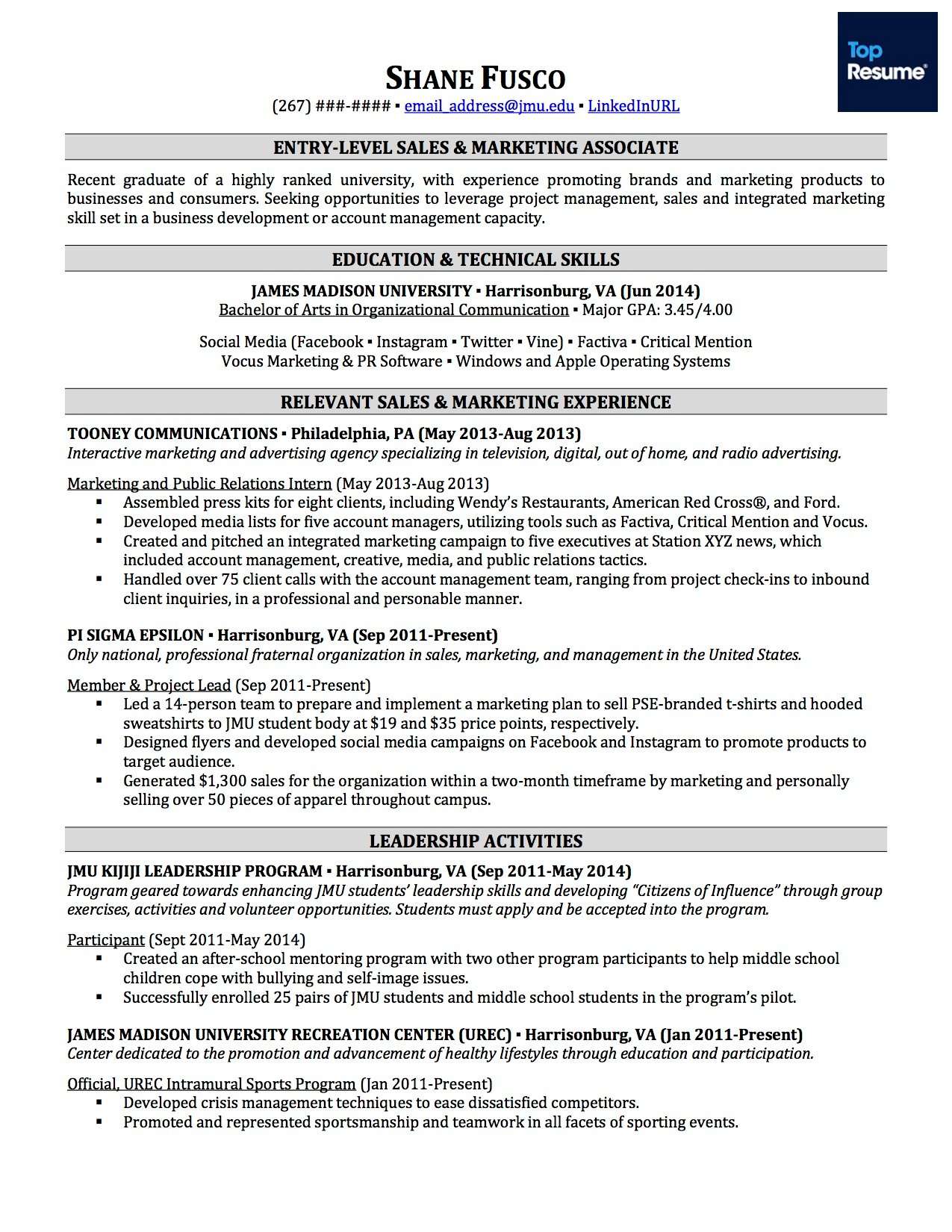
Source: topresume
A functional resume is a resume format focused more on highlighting your skills and expertise over work experience. This resume format is preferable for individuals who have little work experience, an unfocused work history, lapses in employment, or are in the middle of a career change. New graduates would also benefit from using a functional resume.
In a functional resume, your experience is grouped by skill categories instead of specific employment history listings. You can also list your employment history in a functional resume, but there’s no need to expand on past jobs beyond your job title, your employer, and work dates. A functional resume should include elements like personal and contact information, a resume summary, relevant skills grouped into skill categories, and work and education history.
Pros and Cons of Using a Functional Resume
- Highlights skills as well as experience
- May elevate your most relevant qualifications by featuring them higher on the page
- Disguises any employment gaps
- May give the impression that you lack a steady work history
- Depending on your formatting choices, these resumes can be hard for applicant tracking systems to read
- May not be as effective as combination resumes, which provide some work history in addition to skills
Who Should Use a Functional Resume
Workers who have gaps in their resumes, relatively little work experience, and those who want to change jobs might find a functional resume format useful. However, be aware that recruiters and hiring managers will still look for your work history. Write a carefully crafted cover letter to highlight transferable skills and other qualifications that might make up for a lack of experience.
Related: How To Create A Resume With No Work Experience
Functional Resume Sample
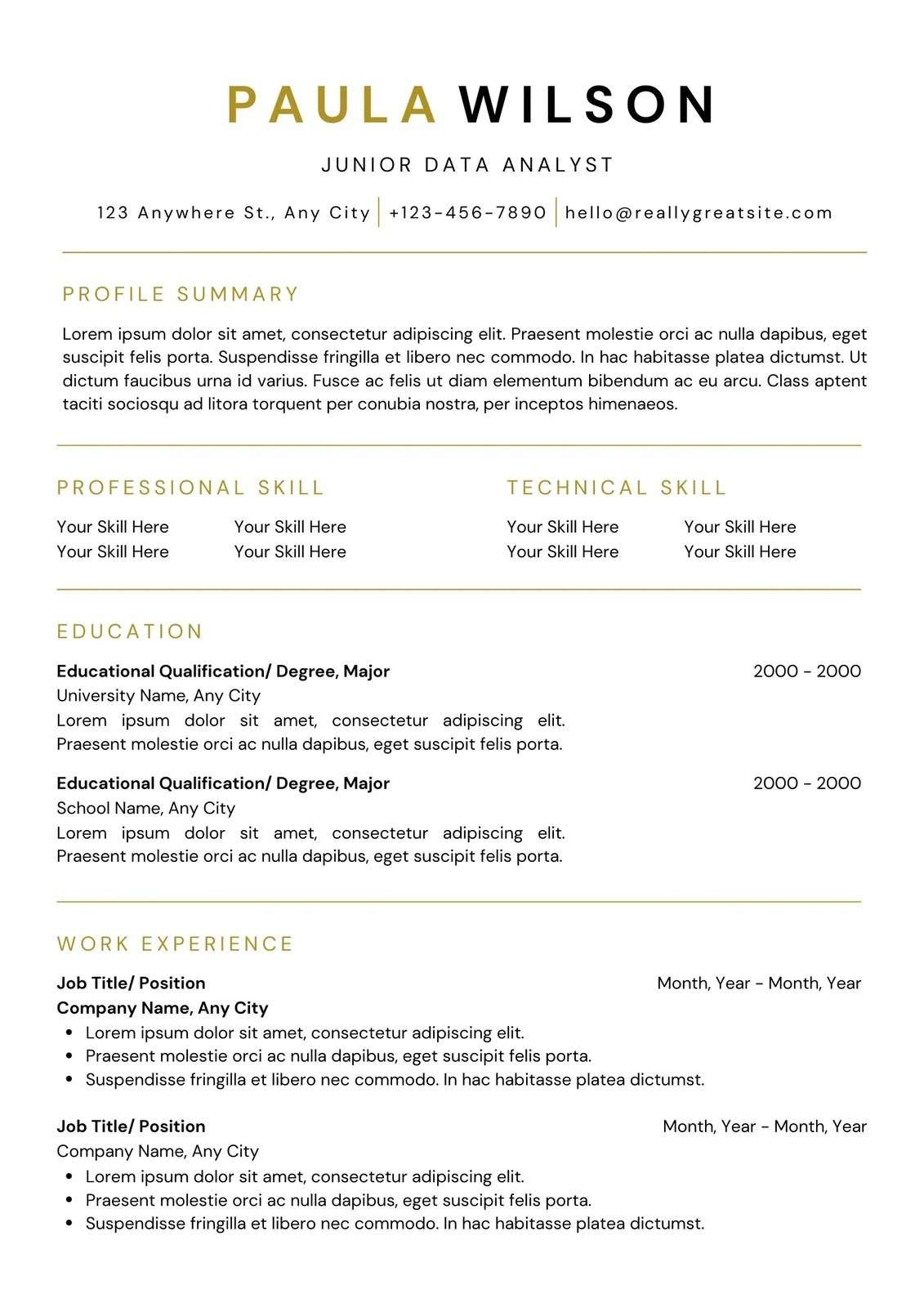
source: canva
As the name suggests, a combination resume combines other resume formats to highlight both your chronological work history and your skills and expertise.
A combination resume is a good choice if you have transferable skills across a varied range of work experiences or if you have relevant technical skills you’ve used over your entire career. This resume format would include elements like personal and contact information, a brief summary, a detailed technical skills section, and work and education history.
Pros and Cons of Using a Combination Resume
Join The Break Community
- Offers many of the best features of chronological and functional resume formats
- Highlights both skills and work history
- May be repetitive if you have similar skills that apply to different positions
- Combination resumes can be longer than chronological and functional formats
Who Should Use a Combination Resume
Mid-career professionals and workers with lots of related experience and skills might consider this format. Just be prepared to be ruthless about what you include in your combination resume. Don’t go back more than 10 or 15 years in your work history and be sure to emphasize skills that are most relevant to the job.
Combination Resume Sample
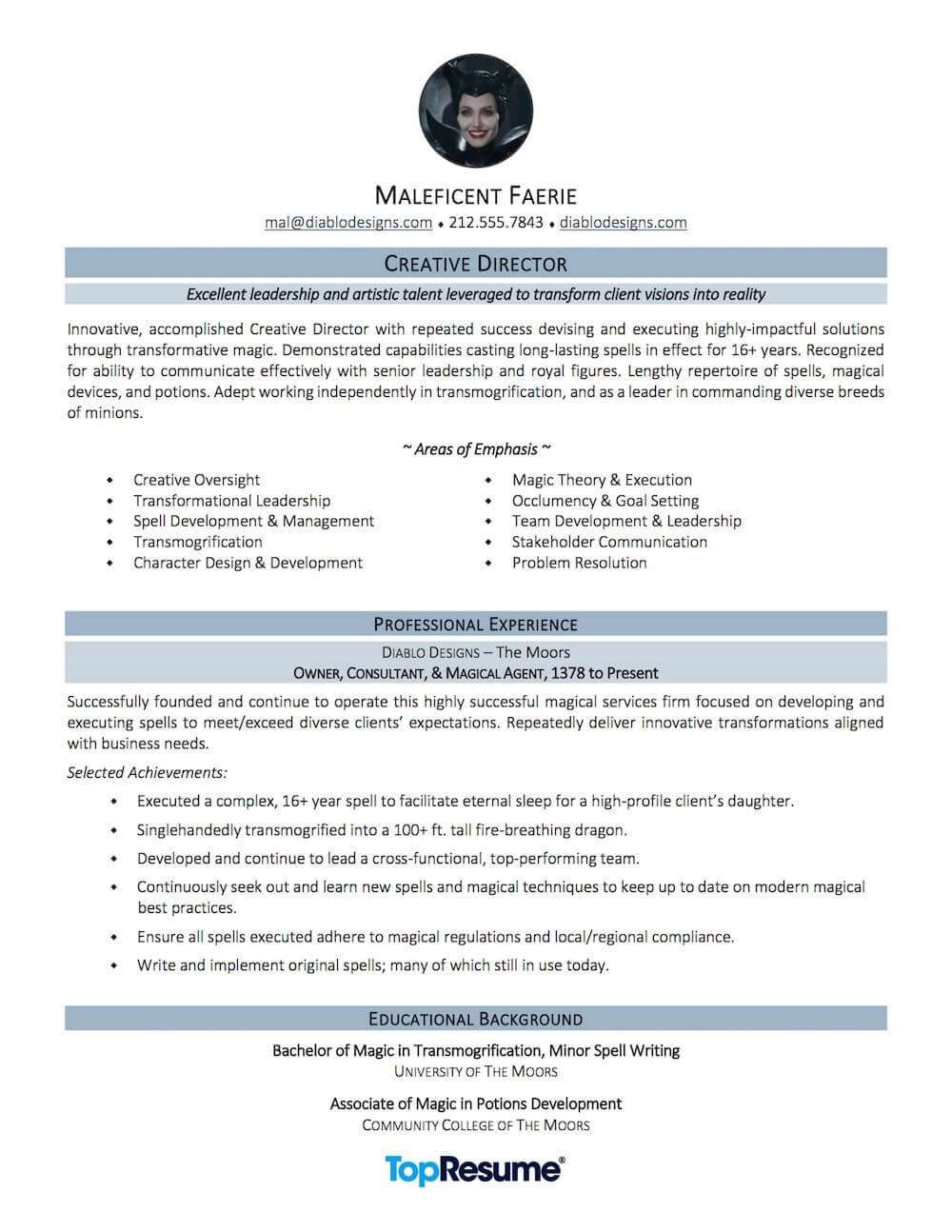
Source: Topresume
A mini resume isn’t as common as the other formats but has its place. Mini resumes are truncated versions of your full resume, highlighting your work experience in the form of a short bio. Mini resumes don’t even need to be on a full-size piece of paper. It could be printed on a handout the size of a business card or notecard.
Mini resumes are to have on hand if there’s a chance encounter and you need something to pass out. This is a good format to use if you attend networking events or conferences where people exchange business cards. A mini resume gives you something to pass out that’s more than just your name and phone number. Include elements like your name, contact information, and a bite-sized bio, including any relevant experience or certifications.
Pros and Cons of Using a Mini Resume
- A great networking tool for trade shows, conferences, and professional groups
- If you include a link to your website or LinkedIn profile , can act as a lead generator
- Not a replacement for a full-length resume
- An old-fashioned business card may be sufficient
Who Should Use a Mini Resume
Anyone who’s planning to attend a professional event or conference can benefit from bringing their short-form resume along. Just be aware that it isn’t a substitute for your full-length CV.
A targeted resume is a resume format that is customized specifically to the open position you are pursuing. Every element of your resume, from your work and education history to your skills, align with the requirements listed in the job description. A targeted resume is the format to use if you’re seeking a specific position within a company. It’s not the type of resume you send out to several companies hoping to land a job.
If you’re thinking of using a targeted resume, take time to study the job posting, paying attention to the skills required (and desired), duties, and any other information that you can use when crafting your resume. Include any keywords mentioned in the job listing in your resume. Research the company, too, for insight into its values.
Targeted resumes are great if your skill set and work history match up well with the job description.
Pros and Cons of Using a Targeted Resume
- Shows the hiring manager that you’re interested in this specific job, not just any open position
- Appeals to applicant tracking systems, which typically look for keywords associated with the position
- None, unless you forget to customize your resume for the next job opening
Who Should Use a Targeted Resume
Short answer: everyone. Targeted resumes are the best way to demonstrate that your skills, training, and experience make you an ideal candidate.
The best resume format for you depends on your career level, work history, skill set, and qualifications. The job you're targeting will also play a role.
To determine which resume type to use, ask yourself the following questions:
How much related work experience do I have? If you have several years of steady employment in the industry and your career path shows regular promotions and several years at each employer, a chronological resume or combination resume may be a good choice.
What are my most relevant skills and qualifications? Read the job description in the listing and figure out which skills, certifications, and abilities are most desirable for this job. If you can check off most of those qualifications, consider a functional resume format (or a combination resume with a skills section).
What are the employer's specifications? Sometimes, employers will share their application requirements. When they do, you should follow instructions. For example, they might say that they want someone with experience in the industry, which would indicate a chronological or combination resume.
What are the expectations for my industry? Different industries have different rules for job seekers. For example, Georgetown Law's Office of Career Strategy notes that law students should list their education first and keep their resume to one page.
How will I be submitting my resume? If you're applying via email or online system, remember to format your resume so that it's readable by the resume bots. Skip the fancy formatting, images, and other visual elements.
Whether you're writing your first resume or buffing up a mid-career CV, you don't need to go it alone. We've reviewed the best paid experts, free tools, and online resources to help you make a good impression on the hiring manager.
The Best Resume Writing Services : Sometimes, it pays to call in the professionals. If you're not getting interviews and you're not sure why, resume writing services can help. Many come with a free trial or money-back guarantee.
The Best Resume Builders : These online tools can help you optimize your resume for applicant tracking systems, customize them for a specific job, or start an entirely new document from a template. Most have free versions.
The Best Resume Templates: To make a positive impression, your resume needs to be professionally (and consistently) formatted. These free and low-cost resume templates can help.
After your resume is polished and ready to go, you may be looking for new job opportunities. To help you out, our team has reviewed the top job posting sites .
The three most common resume formats are the chronological resume, the functional resume, and the combination resume. You may also see references to the mini resume, which is a short summary of your skills and experience intended to be passed out at conferences and tradeshows. And, a targeted resume is any type of resume that is customized for a specific job.
The best resume type depends on your career goals and work experience. Chronological resumes are the most common format and are perfect if you have a long work history with no gaps. If you don't have much work experience, a functional or combination resume may be a better option. Choose a resume format that matches your experience, the job, and the employer's requirements.
The three most common resume styles are chronological, functional, and combination. Each resume type has pros and cons. For example, a chronological resume format may be a poor choice for an entry-level worker or a career changer but an excellent choice for someone with extensive work experience in their field.
The work history listed on your resume should only go back 10-15 years unless it's relevant to the job position. Be aware that including more work history may reveal your age and expose you to bias.
There is no one best resume type or format. You can choose different resume styles for different jobs, employers, or phases of your career. The most important thing is to look for opportunities to show the hiring manager why you're the best candidate for the job.
Now that you know what type of resume to use, you can polish your resume and start applying for jobs! We recommend starting your job search on ZipRecruiter !
Michael Gardon
Mike is our Founder, career coach, and resident expert on all things resume, hiring and work-life. He is author of The Break newsletter and host of The Break Podcast on Careercloud. He has seen everything from being hired (and fired) to hiring and managing hundreds of people over his career. Mike has also successfully navigated many career pivots. He is a former derivatives trader turned corporate consultant turned entrepreneur who also holds a Bachelors' Degree from the University of Wisconsin-Madison and an MBA from DePaul University in Chicago. Mike is often interviewed and quoted on career topics in major publications such as Business Insider, Forbes, USA Today, Yahoo Finance and Fox News. Mike resides in the beautiful midwest where he built a life around his family. Connect with Mike to talk purpose, career change, entrepreneurship and side hustles like Quotebook , which he built with his kids!

Best Time Tracking Software of 2024

How To Create A Resume With No Work Experience
Want to build an unbreakable career.
- Resume Tips
Resume Format Types: Examples & Which Option Is Best?

12 min read

When it comes to resumes, many people get so focused on the details they’ll include in their presentation that they often neglect one of the most important decisions they need to make: the resume format.
While there are no hard and fast rules where resume format is concerned, it is still wise to select from one of the types of resumes that have the best track record for success.
Which resume format is right for you depends on your work history, experience level, and the position you are targeting. To better understand which option might be best for you during the job search, let’s take a look at each resume format separately. After our overview of the best formats, we also explain situations in which one format thrives over the others.
After reading this through you will know exactly which type of resume format is right for you!
The most popular resume format types:
There are currently three format options that are popular in the resume writing industry:
Reverse chronological
Each of these resume types has proved popular with recruiters over the years. They are considered to be easier for applicant tracking system software and human recruiters to review, and present information in a way that recruiters prefer to see. In short, they meet the target audience’s demands.
1. Reverse chronological format
The reverse chronological resume format is currently considered to be the most popular format for resumes and is one of the best resume formats in use today. It provides a well-structured design that enables applicants to highlight both their job history and work experience, beginning with the most recent job held. Basically, it is a tour through the applicant’s employment history that starts in the present and works backward into the past.
Employers often prefer this type of resume formatting due to its simplicity. It provides them with an easy way to review job history, quickly identify potential gaps in employment, and locate specific achievements and responsibilities that could make the candidate a desirable prospect.
This format is ideal for candidates with a strong work history. To properly execute the reverse chronological format, you should include some specific sections that identify your professional job titles, accomplishments, educational achievements, and relevant skills that might apply to the job you’re seeking. The main objective, though, is to define yourself in terms of your actual career progression.
We also have a comprehensive guide to writing an awesome reverse chronological resume .
Example of the reverse chronological format:
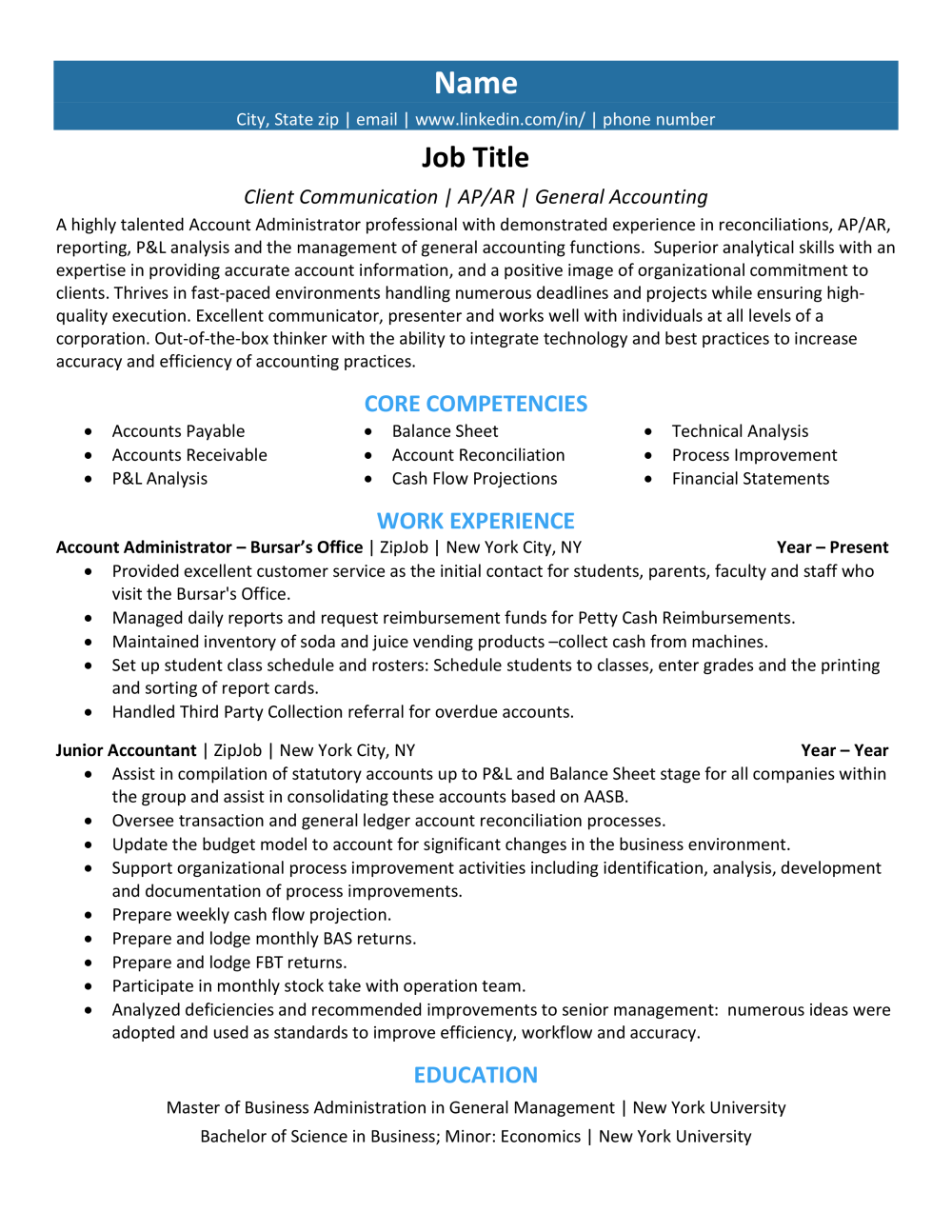
When should you use a reverse chronological resume format?
Are you on a steady career path that demonstrates vertical progression and continual career advancement?
Do you have a steady record of continuous employment without any significant gaps between jobs?
Are you currently applying for a position that is in the same field that you’ve been working in, or one that is similar enough to make your previous experience relevant?
If so, then the reverse chronological format could be the best resume format for you!
Key Takeaway
The chronological format is great for people with consistent work history and when applying for a position you have experience in.
2. Functional resume format
The functional format takes a different approach. Rather than focusing on your employment history, the functional resume format emphasizes your actual marketable skills.
Its entire objective is to showcase the abilities that you have that would make you a great candidate for the job you’re seeking. It de-emphasizes the work experience section, choosing actual skills over prior jobs.
Where the reverse chronological format begins with a recitation of your various jobs, the functional resume template instead begins with the skills you bring to the table. It places those skills front and center, listing them right at the beginning of the resume – along with specific relevant achievements that further demonstrate your strengths and suitability for the job.
Of course, your prior employment does get a mention, but only in an abbreviated form that includes the names of the companies you worked for, your position at those firms, where they were located, and the dates of your employment.
After that section, you include another brief section listing your educational accomplishments, in reverse chronological order.
As you can probably tell from the structure described above, the functional resume template is designed to shine a white-hot spotlight on your qualifications for the job in stark terms that emphasize your actual, demonstrable skills.
It gives only scant lip service to how you developed those skills or where you’ve used them in the past. It instead places those skills front and center, enabling the recruiter to quickly assess your ability to do the job.
Example of the functional resume format:

When should you use a functional resume format?
Are you looking for an effective employment gaps resume format that can successfully downplay any lengthy periods of non-employment?
Are you returning from illness or injury and are trying to reenter the workforce?
Have you perhaps been restless throughout your career, and found yourself frequently changing jobs?
If so, then the functional resume format could be ideal.
Of course, there are other times when this format might be perfect as well. For example, you could just be looking for a change in career, and a way to make a career transition to a new line of work. Or maybe you have concerns that you aren’t exactly what most recruiters might be looking for when they’re trying to fill certain positions.
In either of those cases, the functional format can provide a way to demonstrate that you have the right skills, even if you lack other qualities or experience that the employer is looking for.
The functional format is great for people with large employment gaps, little work experience, or people who are changing careers or industries.
Tip: The functional resume has gained a reputation recently for being the format people choose when they have something to hide. While it still has its time and place, weigh your pros and cons before committing to the functional resume format.
3. Hybrid resume format
The hybrid resume format is a combination that combines elements of both the reverse chronological and functional formats. It can be an effective way to showcase both the skills that you possess and your successful history of applying those talents in the marketplace.
With the hybrid resume template, you should begin with a profile or summary of your qualifications. This introductory section typically includes all your most relevant skills and abilities, as well as the achievements that demonstrate your ability to do the job. This focus on skills is obviously the functional component of this format style.
There is also a reverse chronological aspect, as the introduction is followed by details about your experience and education, as well as any additional information that you include. This fusion of the two main formats provides a clearer picture of everything that makes you qualified to fill any given position that you seek.
Example of the hybrid resume format:
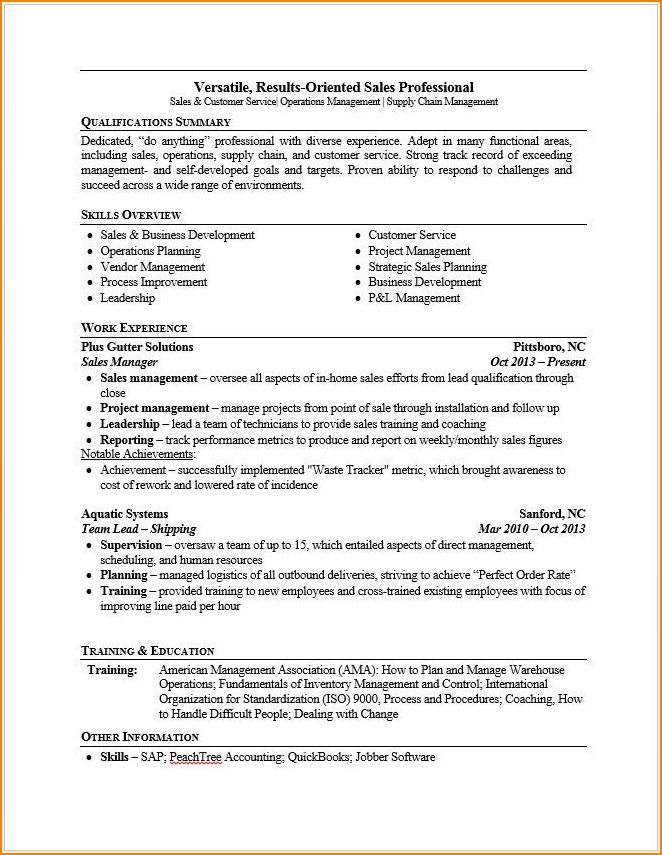
When should you use a hybrid or combination resume format?
Have you spent a great deal of time developing relevant skills that you want to highlight? Do you consider yourself an expert at the things you do? Are you in the process of trying to change your career path to a new industry? If so, then this more complete and well-rounded format might be just the thing you need to properly position your candidacy for the job.

Join more than 1 million people who have already received our complimentary resume review.
In 48 hours, you will know how your resume compares. We’ll show you what’s working--and what you should fix.
Which resume format is best for you?
At ZipJob, we favor the hybrid format. It is a good balance of skills and work experience, and gives ample opportunity for relevant keywords. However, it might not be the best resume format for you.
As helpful as it might be to better understand the various format types, that information is of little use if you don’t know when to use each type. Here’s a closer look at how to determine which resume format will work best for your needs.
To determine the type of format that you need to use for your resume, you should evaluate your current goals and the type of information that you need to present to your potential employer or hiring manager. With that analysis in hand, your choice should be obvious.
When to use a reverse chronological resume format:
If you’ve spent years climbing through the employment ranks and are seeking a new job that continues that vertical advancement in your career, then the reverse chronological format is almost certainly your best option. This format can emphasize your employment consistency, and demonstrate your competence in the field.
It is important to recognize, though, that this is not the best format to use when you’re looking to switch careers to an entirely new industry. It is also an inferior choice for anyone who tends to hop from job to job, or who has noticeable employment gaps.
When to use a functional resume format:
The functional format delivers information about your skills like no other format can. Its de-emphasis of job history and educational achievements keeps that skill focused right on target. As a result, it can effectively hide sketchy employment history.
It’s not, however, a format well-suited for anyone who wants to demonstrate career advancement. You also don’t want to rely on it too heavily if you don’t have the right kind of skills for the job you’re seeking, since it declares that lack of qualifications right away. Finally, it doesn’t really provide the best format for people with absolutely no experience.
When to use the hybrid resume format:
The hybrid format can be ideal if you have great skills to highlight and a fairly solid work history. That makes it a powerful tool for anyone who wants to get into an entirely different industry–and can demonstrate the complete mastery of your skills while demonstrating that your expertise extends beyond the theoretical.
The hybrid format is not an effective way for people with no work experience to break into an industry. It’s also a less-than-effective way to showcase educational achievements and experience–which can be especially troublesome if that’s your main qualification for the job. Finally, it’s useless if you lack the needed skills.
The perfect resume format for changing careers
There is near-universal agreement among the experts when it comes to which resume format is best suited for those who want to switch their careers. The hybrid format is ideal for that purpose–and for several obvious reasons:
Organization : the hybrid format combines all your best and most attractive features into one neatly-composed package. It begins with skills, which is exactly what recruiters want to see when they recognize that your prior work experience is in another industry or job type.
Balance : the hybrid resume also succeeds in incorporating important information about your education and work history. Those chronological features help to demonstrate that your skills have practical application in the work environment. That’s critically important for recruiters who need to know that your skills can be applied on behalf of their company too.
Optimization : your hybrid resume can also be used to highlight those less tangible skills that every employer is seeking. Your skill at communication, leadership, and customer relationship management are all invaluable abilities that translate well from one job path to another.
In short, if you find that your career path needs a change, but are uncertain about which resume type will best enable you to get another company to notice you, the hybrid format definitely deserves consideration. Here are some more tips that can come in handy when switching careers.
The perfect resume format for no experience
Of course, there’s another type of format that deserves a mention as well, since it is one that can benefit millions of recent college graduates and others with no experience.
Since none of the three most popular formats really provide a proper vehicle for these new entrants into the employment market, it is important to take a look at some formats that might be of value for those new would-be workers too.
There are two competing schools of thought when it comes to the college graduate resume format. Some experts believe that those entry-level applicants can be best served by adopting a resume format that focuses on skills and specific training right off the bat, with additional information about education. Prior employment and experience would be listed last.
If that sounds like the functional format, then you’ve been paying attention! The problem is, though, that the functional format is really designed for people who have proven skills; for most college grads and entry-level employees, that simply isn’t the case.
We believe that the other option chosen by experts is preferable: a conventional resume that includes a summary statement at the top, with education information listed next. Work experience–including internships , summer jobs, work on campus positions, or volunteer work –can bring up the rear. Most of the heavy lifting for that resume type would be done in the summary.
One thing is certain: the type of resume format you use can be every bit as important as the quality of the writing used in the resume itself! Don’t spend all your energy on one or the other.
After all, no matter how well written your resume might be, it’s all for naught if the recruiter or hiring manager isn’t immediately drawn in by the way that information is presented. So, choose your format wisely to ensure that you maximize your opportunity to achieve your career goals!
Related posts:
LinkedIn Background Photos
Please Find Attached My Resume: How to Use This Phrase
How Long Your Resume Should Be (Expert Advice)
Leo Bastone, Editor & Content Writer
Leo Bastone is an Editor with a passion for using words to empower high-growth and mission-driven organizations. He’s worked in startup, non-profit, and enterprise environments across various sectors and currently serves as an editor at ZipJob. Based out of the greater New York City area, Leo enjoys traveling frequently throughout New England, one of his favorite hideaways being the Pioneer Valley of western Massachusetts.

Is your resume working?
Find out with a free review from ZipJob.
Get a free resume review today
Our experts will review your resume’s grammar, layout, and ability to pass ATS — all free and delivered straight to your inbox.
PROTECT YOUR DATA
This site uses cookies and related technologies for site operation, and analytics as described in our Privacy Policy. You may choose to consent to our use of these technologies, reject non-essential technologies, or further manage your preferences.
The opinions expressed are solely those of Find My Profession. Click to see our Advertising Disclosure.
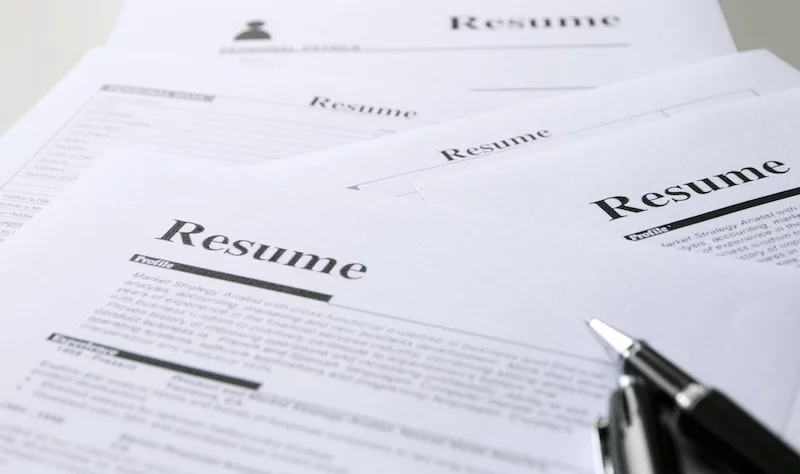
7 Different Types of Resume Formats [+ Samples]
Learn about different resume formats and when to use each one. Chronological, functional, combination resume samples & more.

There are seven different types of resume formats you can use when creating your resume.
Different formats work better for different situations, depending on your experience and career goals.
In this article, you will learn about these various resume layouts and see which will work best for you.
You need a professional resume format that will show off your best assets (and downplay the rest).

Different Types of Resumes
The seven different types of resumes that we will discuss in this article include:
- Chronological Resume
- Functional Resume
- Combination Resume
- Infographic Resume
- Mini Resume
- Profile Resume
- Tailored Resume
Read on for a summary of each type of resume along with samples or click on a shortcut above.
1. Chronological Resume
A chronological, or reverse chronological, resume lists your work history starting with the most recent experience first.
This is the most common resume format. When you think of a basic resume, this is it.
Recruiters and employers like to see a chronological resume because it clearly lays out a thorough description of your work history. It is also easy to find information since this is the layout decision-makers see most often.
A chronological resume works best for:
- Professionals with a solid work history related to the job being applied for
- Job seekers without employment gaps
- Applicant Tracking Systems (ATS)
Chronological resume sample:
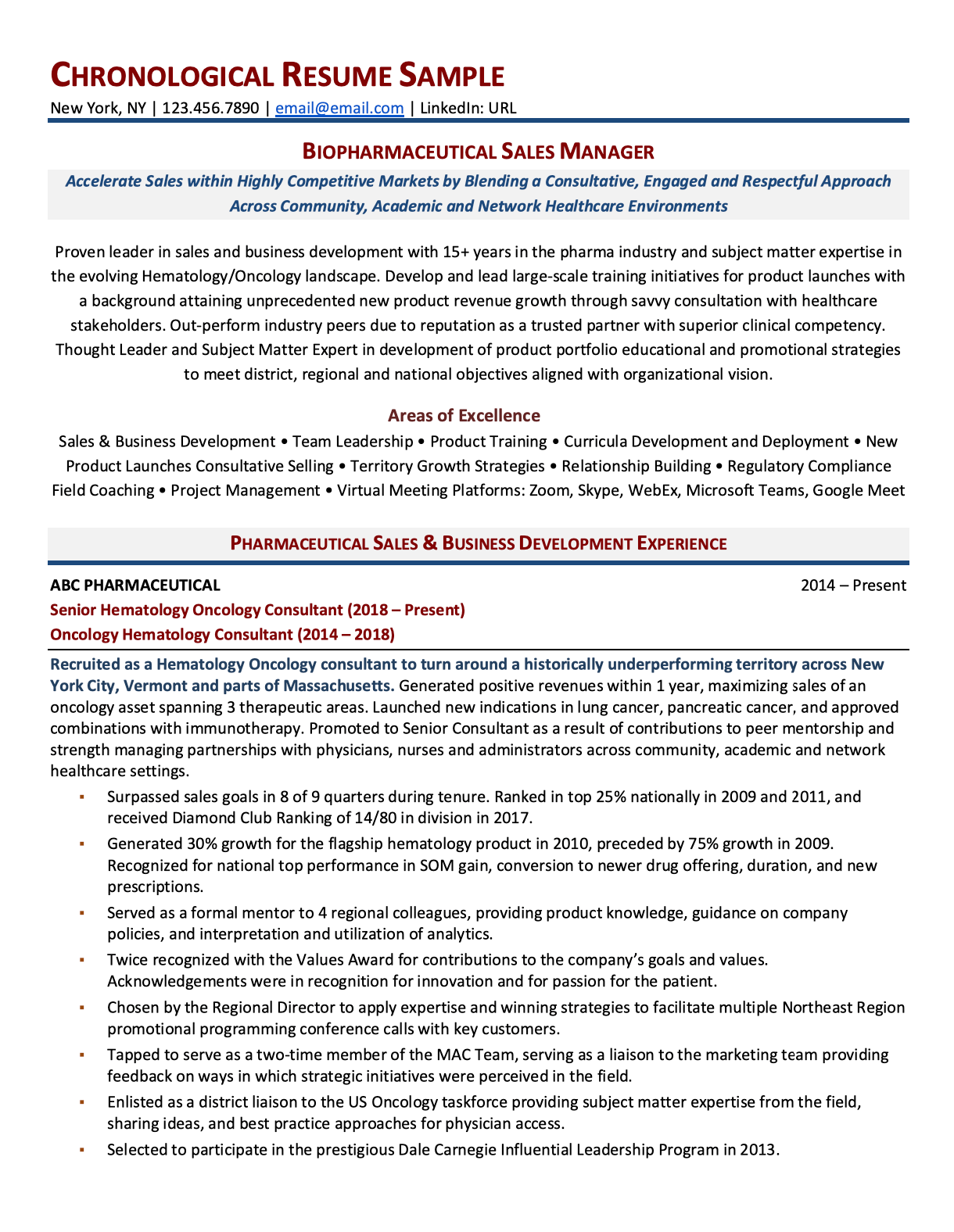
Click on the sample above to see the full resume.
2. Functional Resume
The functional, or skills-based, resume focuses on your skills and experience more than your job history.
Instead of having a detailed “work history” section, you will include expanded sections on your resume that list your skills and relevant achievements.
You can also add a summary and headline at the top of your resume that highlights your skills and achievements.
Instead of focusing on your employment history (that may be lacking), you are highlighting the skills you have that align with the job you are applying for.
A functional resume works best for:
- Job candidates with gaps in their employment history
- Professionals changing careers
This format is losing some popularity as it is not ideal for applicant tracking systems.
Functional resume example:
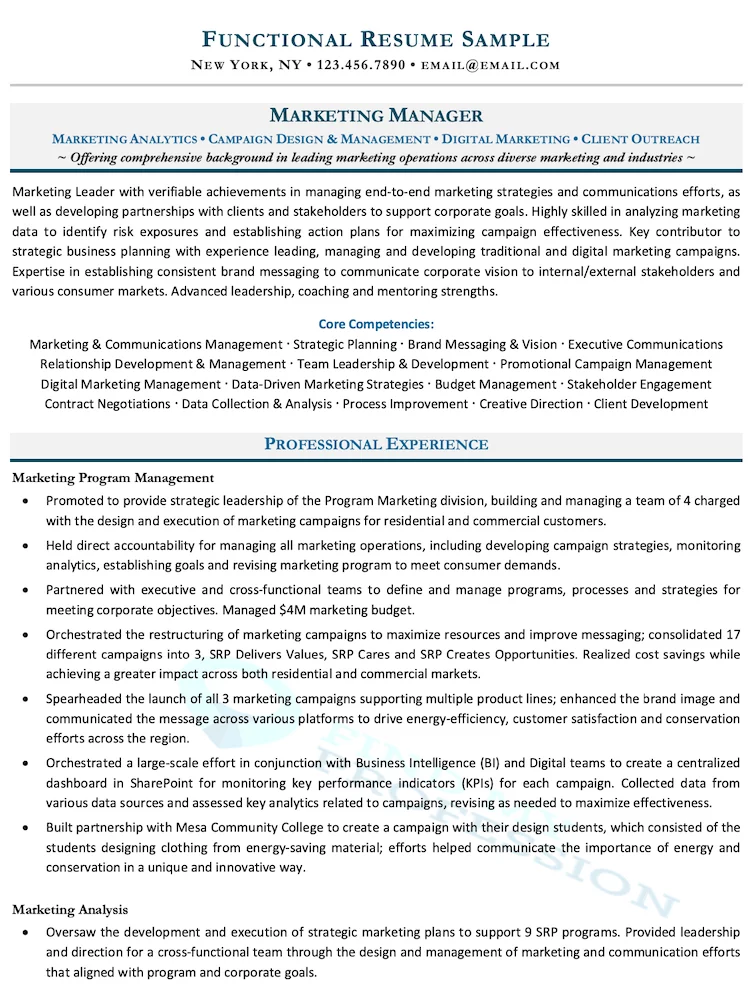
3. Combination Resume
As the name suggests, a combination, or hybrid, resume combines chronological and functional resume formats.
The top of the resume includes your skills and qualifications relevant to the job you are applying for. Below that is your chronological work history.
Your work history is not the main focus so it doesn’t take up a lot of space.
This format offers the best of both worlds. You can accentuate your skills and show off your related work history.
A combination resume works best for:
- Professionals with relevant skills and experience and employment gaps
Combination resume sample:
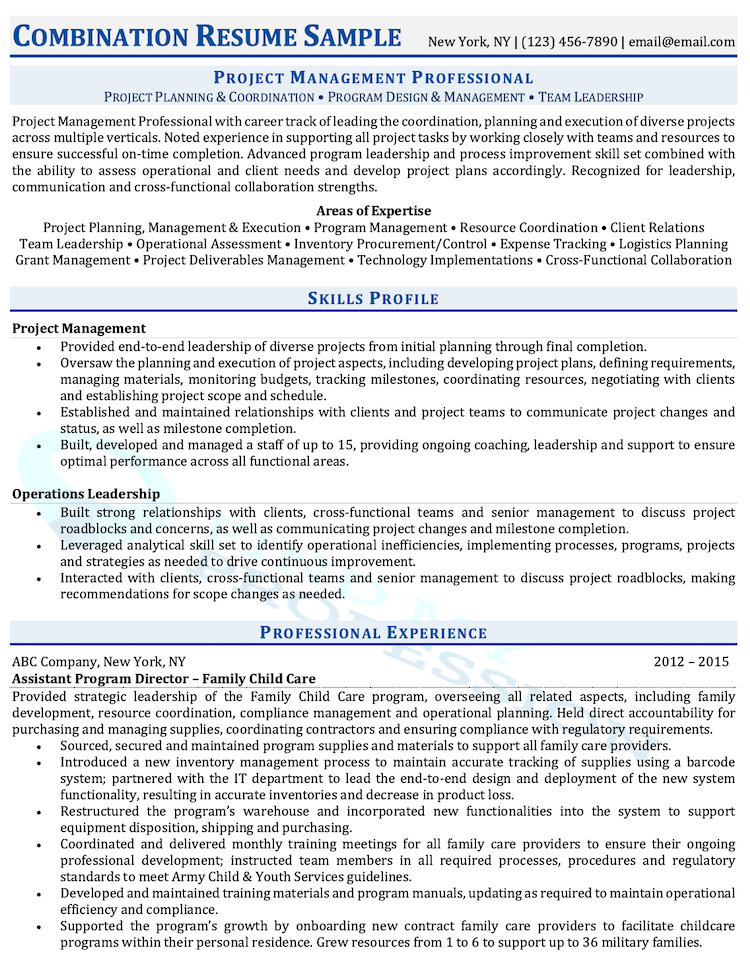
4. Infographic Resume
An infographic, or networking, resumes are resumes with graphic design elements instead of just text. It uses various design elements with a focus on the aesthetics of the resume.
These resumes achieved higher popularity several years ago when infographics first came out, but since then have seen a decrease in usage.
If you are skilled with graphics and competing for a role that will use these skills, this may not be a bad choice for your resume format.
Infographic resumes use layout, color, design, formatting, icons, charts, and font styling to present your information.
An infographic resume works best for:
- Design-related professionals
- Networking and emailing directly to decision-makers
The biggest con for infographic resumes is that many ATS cannot properly read the content on your resume accurately, rendering them virtually useless for screening purposes.
Infographic Resume sample by Venngage :
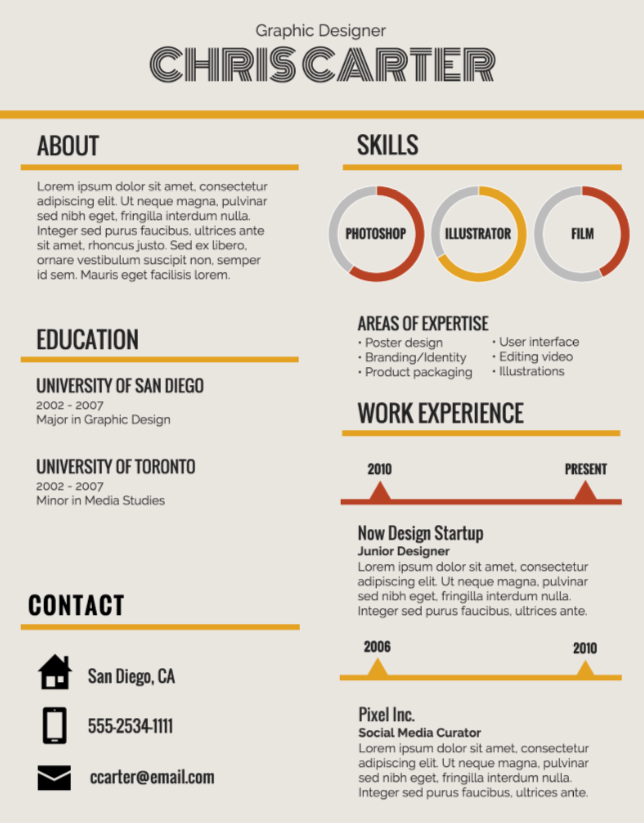
5. Mini Resume
A mini resume is a brief summary of your career highlights and qualifications.
It only contains the information most specific to the job and industry.
They are straightforward networking tools that easily answer the question, “So what type of work are you looking for?”
Mini resumes have been known to fit on a business card or postcard. They are easier to read than a full-length resume and provide more information than a business card.
A mini resume works best for:
- In-person networking events
Mini resume sample by The Balance Careers :
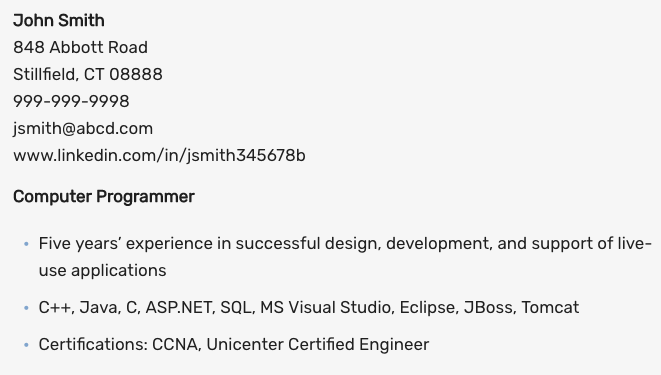
6. Profile Resume
A profile resume describes a resume that uses a resume profile, more commonly known as a resume summary or professional summary, instead of an objective statement.
A resume profile is a professional summary of your skills, experiences, and goals related to a specific job at the top of your resume. The summary includes a couple of skill and accomplishment-packed sentences with a sales pitch.
The term profile resume isn’t really used anymore as objectives have gone by the wayside and including a professional summary on your resume is common practice.
Resume profiles are helpful for most job applicants and can be included in any resume layout.
A resume with a profile or summary works best for:
- Professionals with extensive experience to sum up your experience to the hiring manager quickly
- Professionals with limited work experience to help you highlight relevant skills for the position
7. Tailored Resume
A tailored, or targeted, resume is customized to specifically highlight your experience and skills related to the job for which you are applying. It also uses keywords from the job posting throughout the resume.
Any of the other resume formats can, and should be , tailored to the job you are applying for.
This resume format says, “This is exactly what I can do for you,” instead of, “Look at all the stuff I have ever done.”
Tailored resumes are becoming more popular with the increase in the number of resumes companies receive.
Because of the increasing numbers of resumes companies receive, more and more are relying on an ATS, which searches your resume for keywords.
When your resume gets to a human, they only want to see the information relevant to the role they are filling so they can make a quick decision.
While it takes more time and effort to write a tailored resume than a generic resume, it’s definitely worth the effort.
A tailored resume works best for:
- Eliminating information that only somewhat applies to the job you want
- Being honest with yourself about the job you should be applying for
- Getting practice in presenting yourself to employers and recruiters
Key Takeaways
There are several formats you can use for your resume.
Choose the best one for your background and career goals:
- A chronological (or reverse chronological) resume focuses on your work history.
- A functional (or skills-based) resume focuses on your skills.
- A combination (or hybrid) resume combines your skills and work history.
- An infographic (or networking) resume is great for in-person or digital networking.
- A mini resume fits your key information on a business card-sized document.
- A profile resume includes a resume summary (or professional summary).
- A tailored (or targeted) resume is customized to a specific job.
Were you able to find the best resume format for your situation?
If not, we provide more details about selecting the best resume for you here . If you’d rather have a professional take care of it for you, we’d be happy to help! Contact us to see what we can do for you!
Recommended Career Advice For You

11 Best Engineering Staffing Agencies in America (2024)

Getting Fired: Meaning, Tips & Moving Ahead
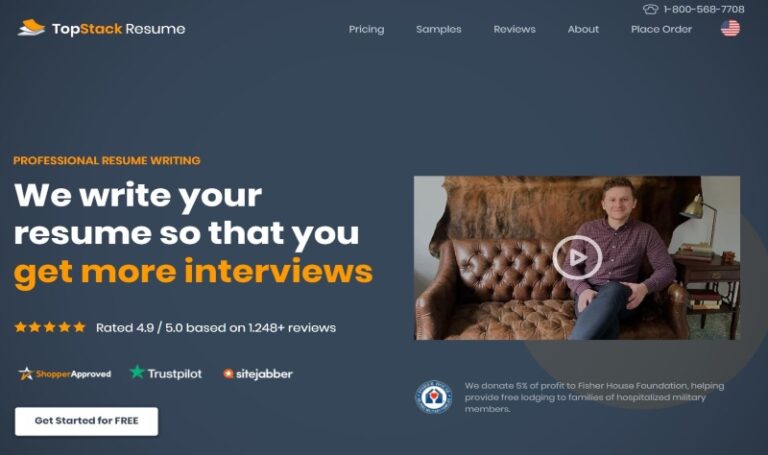
TopStack Resume Review [Cost + Customer Reviews]
The 6 Types of Resumes (+ Which One Fits You Best)

You know, a professional resume is more than just a list—it's a way to position yourself as the right fit for a role.
There are actually six types of resumes to consider—each one designed to highlight experience and skills in a different way.
Understanding these resume formats and choosing the right one for your industry, experience, and personal strengths can elevate your qualifications and present your career journey in the best possible light.
3 key takeaways
- The six different types of resumes and their benefits
- Which resume format is best suited for your industry
- Creating a professional resume with Teal’s AI Resume Builder
Teal Note: Unless you’re a student, recent graduate, or pivoting careers, a chronological resume is the best way to showcase your career journey in a straightfoward, easily recognizable way.
1. Chronological resume
The most common (and most preferred) resume format is the chronological resume.
As its name suggests, this resume lays out your work experience in reverse chronological order. Meaning your most recent job takes the top spot, and the rest follow in descending order.
Key industries: Fields like finance, law, and healthcare favor this format, but it's versatile enough to work for most sectors. It's a hit among recruiters and hiring managers, as it offers a clear view of your career trajectory, highlighting consistent growth and dedication.
Formatting specifics: Start with your contact details and a concise resume summary. Next, list your work experience, with the job title, company name, location, and the dates you were employed.
Beneath each role, outline key achievements. Conclude with your education, certifications, and any relevant skills or tools you're proficient in.
Why it's a good option: The chronological resume format is straightforward and intuitive, making it easy for employers to see your professional experience. If you've had a steady career without many gaps and you're staying within the same industry, this format best showcases your expertise and progression.

Benefits of a chronological resume
- Clarity and cohesiveness: This format provides a clear roadmap of your career journey. For readers, it's like flipping through a well-organized storybook where they can easily trace the main character's progression.
- Immediate insights: A chronological resume's structure lets hiring managers immediately gauge your recent roles, responsibilities, and growth—all vital insights.
- Industry favorability: As mentioned earlier, several industries prefer the chronological format. It adheres to their expectations and offers a conventional appeal.
- Spotlight on accomplishments: The chronological format showcases your accomplishments, potentially making you a more desirable candidate.
Does this format fit you best?
This style is a perfect match for those with a consistent work history and minimal employment gaps.
If you're climbing the ladder within a specific industry or field and want to highlight your upward trajectory and accomplishments, this format will serve you well.
2. Functional resume
At its heart, the functional resume format is all about skills and qualifications over chronological work history.
Instead of focusing on job titles and the duration of your employment, this style hones in on your abilities, expertise, and specific competencies.
Key industries: This format is a favorite among freelancers and consultants with varied experiences across different projects and clients.
Formatting specifics: Begin with your contact details and a robust summary emphasizing your core competencies. Instead of a timeline of jobs, curate categories based on skills or areas of expertise, like "Project Management" or "Graphic Design."
Under each category, use bullet points to list achievements and experiences that validate your proficiency. Of course, you'll wrap things up with your education and any other pertinent details.
Why it's a good option: For those with gaps in their employment or a diverse range of short-term projects and roles, the functional format is a life-saver. It allows you to focus on your strengths, irrespective of when and where you acquired them.
Benefits of a functional resume
- Skills showcase: This format is an excellent stage for your talents and proficiencies, allowing you to portray your value proposition upfront.
- Gap guardian: Had a hiatus or two in your career? The functional resume deflects attention away from employment gaps, focusing instead on what you can do.
- Flexibility and freedom: For those with a broad spectrum of experiences, the functional style offers the liberty to strategically tailor content, emphasizing relevant skills for the role at hand.
- Adaptability: Transitioning industries or roles? This resume lets you present transferable skills, which can be a catalyst for making successful switches.
The functional resume might be your best ally if you've juggled diverse roles, taken sabbaticals, or are looking for a career change. It's particularly apt for those who want their skills to do the talking rather than a linear job history.
On the flip side, some recruiters are wary of this format, as it can be difficult to correlate skills with specific roles. So if you're in a traditional field or have a straightforward career path, a different format might be more advantageous.
3. Combination resume
Meet the hybrid powerhouse: the combination resume. Merging the best of both worlds—chronological and functional—it offers a balanced take on your work history and the skills you bring to the table.
Key industries: Due to its versatility, the combination format finds favor across a multitude of sectors. It's especially handy for students, recent graduates, and those just starting out as it offers a blend of experience and skills.
Formatting specifics: Kick things off with your contact information, followed by a punchy resume summary. Up next is a competencies and hard skills section.
Then, flow into a chronological account of your employment history (possibly in a more condensed form than in a purely chronological resume). And as always, cap it off with your educational credentials and any additional relevant information.
Why it's a good option: The combination resume is the Swiss Army knife of the best resume formats . It lends the latitude to play up strongest suits, like skills or your storied career journey, while providing a structured timeline of your professional past.
Pro Tip: The Teal AI Resume Builder has a Drag-and-Drop Editor so you can arrange the sections of your resume however you want.
Benefits of a combination resume
- Best of both worlds: Enjoy the structure of a chronological resume with the skill emphasis of a functional one.
- Tailored pitch: Given its dual nature, you can tweak the emphasis based on the job you're aiming for, making your application more adaptable and relevant.
- Comprehensive yet concise: While it showcases both skills and job history, the combination format encourages brevity, ensuring your resume isn’t just informative but also reader-friendly.
- Career progression + skill depth: This format allows employers to see where you've been and dive deep into what you can offer.
If you're just starting your career or a professional with a mix of varied roles and hard-won skills, the combination resume might be your golden ticket. It's especially good for those looking to highlight how their experiences and abilities align perfectly with a specific role.
That said, it can be a little longer, so it's important to keep content tight. One page for ten years of less of experience is ideal. If you’re at a stage where both your skills and experiences are pivotal to your next role, the hybrid style is worth considering.
4. Targeted resume
The name says it all. A targeted resume is laser focused, tailored for a specific job or role. Instead of a general overview of your career, this format hones in on the experiences, skills, and accomplishments directly relevant to the position you want.
Key industries: Any industry that values precision and specialization can appreciate a targeted resume. Whether it's tech, where specifics of coding languages or platforms matter, or marketing, where niche skills like inbound certification or PPC expertise can set you apart, this format shines.
Formatting specifics: Start, as always, with your contact details and a bespoke resume summary, tuned to the role at hand. List your work experience, but selectively—only those roles and tasks that resonate with the job description.
Similarly, cherry-pick skills and qualifications that match the job's requirements. Conclude with your education and any certifications or training applicable to the role.
Why it's a good option: A targeted resume is the epitome of relevance. In a sea of generic resumes, this format stands out, signaling to employers your keen interest and alignment with the role. It can also be useful if you have a long, varied work history to condense down to a one-page resume .
Benefits of a targeted resume
- Precision power: Every element of your resume speaks directly to the role, ensuring zero fluff and maximum impact.
- Increased relevance: By mirroring the job's requirements, your resume is likely to resonate more with hiring managers, boosting your chances of being shortlisted.
- Adaptable approach: While it requires more effort, this format can be tweaked for various roles, ensuring you always put your best foot forward.
- Demonstrates commitment: Crafting a targeted resume shows potential employers that you've done your homework and are genuinely interested in the role.
The targeted resume is ideal for those who are very clear about their job aspirations and are willing to put in the extra effort for each application. It's especially good for roles where the competition is fierce or when applying to highly specialized positions.
However, it may not be the most time-efficient choice if you're casting a wider net in your job search. If specificity is your game, and you believe in quality over quantity in job applications, then go with the targeted approach.
5. Infographic resume
When visuals dance in harmony with words, you get the infographic resume. A colorful deviation from traditional text-based resumes, this format leans on graphics, charts, and designs to encapsulate your career story in an engaging and visually compelling manner.
Key industries: Infographic resumes find their natural habitat in creative fields like graphic design, advertising, digital marketing, and multimedia.
Formatting specifics: While the core elements—contact information, experience, skills, and education—remain consistent, how you present them changes.
Use bar graphs to depict skill proficiency, timelines for career progression, and icons for contact details. Employ colors, fonts, and layouts that embody your personal brand while ensuring clarity and coherence.
Why it's a good option: In a world where attention spans are dwindling, an infographic resume can capture and retain interest, differentiating you from a pile of traditional resumes.
Benefits of an infographic resume
Visually engaging: The rich, visual nature of this format ensures your resume doesn't just get seen—it gets noticed and remembered.
Showcases creativity: Especially relevant for creative roles, it's a testament to your design sensibilities and your ability to present information innovatively.
Distills information: Complex data or varied experiences can be condensed into easily digestible visual chunks, making it easier for hiring managers to grasp your story.
Creates conversation starters: Unique visuals or data representations can become talking points in interviews, allowing you to steer conversations.
If you're venturing into a field that values creativity, design, or innovative communication, an infographic resume might be your canvas.
Teal Note: If you're applying to any roles where applicant tracking systems (ATS) are used, a more conventional, less designed resume is preferred as the ATS cannot scan heavily designed resumes correctly.
6. Non-traditional resume
Unlike traditional resumes , the non-traditional resume is an umbrella term for any format that shirks convention. This can include video resumes, web-based portfolios, personal landing pages, or even interactive digital CVs that utilize dynamic media and content.
Key industries: Non-traditional resumes are a hit in dynamic sectors that embrace innovation and unique self-expression. Think digital media, video production, web development, content creation, and cutting-edge tech startups. They're also increasingly recognized in sectors open to modern recruitment practices.
Formatting specifics: As varied as the mediums they embrace, non-traditional resumes don't have a fixed format. A video resume might see you introducing yourself and your achievements on camera, while a web portfolio could house projects, testimonials, and interactive CV elements. Just ensure it's navigable, accessible, and relevant to your target role.
Why it's a good option: The non-traditional resume isn't just a document—it's an experience. It offers a multidimensional view of your capabilities, going beyond just qualifications to provide a sense of your personality, creativity, and initiative.
Looking for a standout approach? Teal's Career Hub resources can guide you.
Benefits of a non-traditional resume
- Makes a bold statement: By its very nature, a non-traditional resume announces you as someone willing to take risks and think outside the box.
- Offers depth: Whether it's showcasing a project in a portfolio or narrating your journey in a video, it provides a richer, more comprehensive view of your professional persona.
- Enhanced engagement: The interactive or dynamic nature of such resumes ensures higher engagement, making recruiters spend more time with your application.
- Leverages modern technology : In our digital age, showcasing your comfort and proficiency with newer media can be a strong selling point in many industries.
Embrace a non-traditional resume if you're in a field that celebrates uniqueness and modern mediums or if you believe a conventional resume won't do you justice.
If you're tech-savvy, creatively inclined, or looking to join a forward-thinking industry, this could be your stage. However, be wary when applying to extremely traditional sectors or when an ATS might be in play.
Build a professional resume with Teal
For modern job seekers, navigating the world of resumes can feel like traversing a maze.
But remember, the most powerful resume isn't just about format—it's about content and fit.
With Teal’s AI Resume Builder, it’s easy to create a strong resume that balances powerful content with a clean format. Highlight your skills, build a personalized professional summary, and get real-time feedback and recommendations for improvements to build your strongest resume yet.
Get started with Teal for free today !
Frequently Asked Questions
How do i determine which type of resume is best suited for my career level, can i use more than one type of resume if i am applying to different kinds of jobs, how often should i update my resume, and does the type of resume i choose affect this.

Related Articles
.jpg)
Zety Reviews: Ratings and Customer Feedback

Jobscan Reviews: Ratings & User Feedback

LinkedIn Skills: How to Choose, Add & Delete Skills On LinkedIn [+ Examples]
.jpeg)
How to Add Projects to LinkedIn: A Step-By-Step Guide (2024)
We help you find the career dream..

What are the three main types of resume formats?

We explain the difference between chronological, functional, and combination resumes
Before you start writing your resume, you need to decide how to structure it.
By strategically thinking about which format you use, you’ll present your background to recruiters in the most effective way possible, helping you land more interviews.
There are three main types of resume formats you can use:
Chronological
Combination.
In this article, we discuss the strengths and weaknesses of each approach.
A chronological resume outlines your work experience in reverse-chronological order.
This format starts with a summary of your career highlights and key skills followed by a comprehensive outline of your work experience, starting with your most recent role.
We strongly recommend the reverse-chronological resume format for most applicants.
It is not only the most popular format but also provides key information recruiters expect to see in a logical sequence, making it the most effective.
- Viewed as the industry standard
- Recruiters are familiar with it
- Compatible with applicant tracking systems
- Allows you to provide examples in the context of your work experiences
- Provides a clear structure with little overlap
- Difficult to create for applicants with little or no work experience
To see an effective example of a chronological resume, take a look at this article .
A functional resume format provides a summary of your key areas of expertise.
Instead of listing each position you held by company, you highlight core skills that make you a strong for for the job.
Underneath each skill, you provide examples of how you have demonstrated that skill in the past.
- Can work well for current students with no work experience
- Can help downplay perceived weaknesses, such as career gaps
- Can work for career switchers by highlighting skills that they did not demonstrate in their day-to-day roles
- Generally not looked upon favorably by recruiters
- Does not flow into applicant tracking systems as easily
- Leaves readers looking for basic information, which can cause them to overlook the resume entirely
- Can seem disjointed, as examples of how the applicant demonstrated a particular skill are provided out of context
Combination resumes start out with a functional overview of key skills followed by a reverse-chronological outline of work experience.
While this format is a notable improvement over the functional resume format, it still lacks the clarity and concise nature of the chronological approach.
- Allows for emphasis on skills while still providing outline of work history
- Buries key information that recruiters want to see first
- Content can overlap, as examples are not provided within the work experience section
Additional Resume Formats
In addition to the most common ways to structure your resume, we wanted to briefly touch on the graphic and creative resume formats.
While these formats often incorporate one of the structures we discussed above, we discourage our clients from using them.
Graphic resumes incorporate elements such as photos, logos, symbols, colors, and multiple columns.
This approach can make your resume stand out - but potentially in a negative manner.
Instead of trying to draw attention to your document using fancy formatting, we recommend keeping it simple and letting your experience speak for itself.
Creative resumes take both structure and formatting to an extreme. We advise using them with caution.
Examples of creative resumes we have come across include:
- A “Game of Life” board game layout that walks the reader through the applicant’s life
- A magazine cover layout with a large portrait of the applicant and various headlines
While these formats may be acceptable (and even encouraged) in select creative fields, they are simply inappropriate for the vast majority of professionals.
When it comes to your career, we recommend playing it safe and sticking to a chronological resume format.
That said, it’s good to be aware of other options available to you – especially if you are dealing with a unique situation.
About Resume Pilots
Resume Pilots is an award-winning executive resume writing firm and a proud member of the Professional Association of Resume Writers and Career Coaches. Our previous clients include CEOs and senior executives at the world's leading companies.
As a professional services firm, we take your reputation seriously. We are committed to delivering writing excellence and superior service while operating with integrity and discretion. Recruitment firms we partner with also trust us to consistently deliver quality documents for their clients.
Our writers have studied in the Ivy League and other top-tier universities and have strong writing backgrounds coupled with industry experience.
Here's how we can help you:
Resume, Cover Letter, and LinkedIn Writing Services : If you are looking for end-to-end support, hire one of our professional resume writers to rewrite your documents from the ground up.
Executive Resume Template Downloads : If you plan to prepare your own resume, consider using one of our classic, ATS-friendly resume templates for Microsoft Word.
To learn more about our services, book an introductory call with our founder here or email [email protected] .
- Share on Facebook
- Share on Twitter
- Share on Google
- Share on Pinterest

About the Author Matt Glodz
Matt Glodz is the Founder and Managing Partner of Resume Pilots and a Certified Professional Resume Writer. After studying business communication at Cornell University, Matt worked within Fortune 500 companies, where he noted that qualified candidates were frequently denied interview opportunities due to poorly written documents. At Resume Pilots, Matt combines his business and writing background - which includes prior work for a Chicago Tribune publication - to craft resumes that give his clients the best chance of landing interviews. He works with clients ranging from CEOs to recent graduates and has been writing resumes for over 10 years. He has been quoted on numerous business and career-related topics in outlets including Business Insider, CNBC, Fortune, Glassdoor, The Ladders, and Thrive Global.
Related Articles
How to use the pomodoro technique for an effective job search, how to improve your resume's layout and readability, should you include a professional summary on your resume.

Exploring the 6 Different Types of Resumes
N avigating through the job market requires an impressive resume, one that highlights your skills, experience and achievements effectively. It's the initial step towards getting noticed by recruiters, and it often determines whether you'll move to the next stage of the hiring process.
The right resume format doesn't just present your qualifications but does so in a manner that aligns with your career goals and the specific job you're targeting.
This guide explores the different types of resumes and their unique features, helping you choose the format that best suits your professional profile.
Do I need a resume?
In the realm of job hunting, a resume is more than just a document — it's a marketing tool, a bridge that connects job seekers to potential employers. Its role is pivotal as it provides a concise and compelling snapshot of your professional journey. It encapsulates your work history, skills, accomplishments and unique qualities that make you an ideal candidate for the job.
Moreover, the importance of a well-structured resume is heightened due to the use of Applicant Tracking Systems (ATS) in the recruitment process. These automated software applications streamline the hiring process for employers by filtering out resumes that don't meet specific criteria.
A poorly formatted resume, or one that doesn't include key terms relevant to the job description, may fail to make it past these systems. Hence, understanding different types of resumes and the strategic use of keywords are vital steps toward crafting an ATS-friendly resume that gets you closer to your dream job.
Related: Everything You Need to Know About Writing the Perfect Resume
What different types of resumes exist?
While every resume shares the common goal of selling your professional abilities, not all resumes are the same. Each type has its unique structure, purpose and benefits.
Here are the different types of resumes:
1. Chronological resume
The chronological resume, or reverse chronological resume, is a time-tested format favored by many hiring managers. This format presents your work history in reverse chronological order, with the most recent job listed first and the rest following in descending order.
In a chronological resume, each job listing typically includes the job title, the company's name, the company's location and the dates of employment. Following this information, a list of job responsibilities and accomplishments is given in bullet points. This allows hiring managers to see at a glance not only where you've worked but also what you've achieved in those roles.
This format works particularly well for job seekers with a clear career progression in a single field without significant gaps in employment. It allows recruiters to quickly see the career trajectory and understand how the applicant's experience fits with the new role.
2. Functional resume
A functional resume, also known as a skills-based resume, places the focus on skills and competencies rather than work history. This type of resume usually begins with a summary of qualifications, followed by a list of skills and examples of their use in work or other settings.
The employment history is typically listed towards the end of the resume, often providing only a basic list of positions without detailed descriptions of each role.
This format can be particularly useful for job seekers with gaps in their employment history, those who are changing careers and have skills transferable to a new industry or recent graduates with limited work experience but possess relevant skills acquired through coursework, internships or extracurricular activities.
Related: How to Build a Better Resume in 4 Easy Steps
3. Combination resume
The combination resume, or hybrid resume, merges elements from both chronological and functional resumes. It typically begins with a section highlighting your skills and achievements. This is followed by a detailed chronological work history.
This format allows you to showcase your relevant skills and accomplishments at the top of the document, helping to catch the hiring manager's eye. Following this with a chronological listing of your employment history allows the recruiter to see your work trajectory and understand the context in which you've applied your skills.
The combination resume can be effective for job seekers with a solid employment history who want to change fields or those with a robust set of transferable skills and experiences across multiple sectors.
4. Targeted resume
A targeted resume is tailored specifically to a particular job posting. Instead of a generic resume sent to multiple employers, a targeted resume aligns your skills, experience and qualifications precisely with the job description. Each section of your resume, from the objective statement to the employment history, is customized to highlight why you are the perfect fit for the specific role.
This format can be more time-consuming to create as it requires tweaking your resume for every job application. However, it can pay off, especially when applying for jobs in highly competitive industries. A well-tailored resume can stand out among a sea of generic resumes and increase your chances of securing an interview.
5. Infographic resume
An infographic resume visually presents your career history and skills using charts, graphs, images and other graphic design elements. This format can make your resume stand out and show your creativity and innovative thinking.
Infographic resumes can be particularly effective in fields such as graphic design, marketing and other creative industries. However, it's essential to remember that some applicant tracking systems (ATS) may struggle to read and process these types of resumes, so if you're applying through an ATS, it's better to stick with a more traditional format.
6. Non-traditional resumes
Non-traditional resumes break away from the standard formats and allow for more creativity. These may include video resumes, LinkedIn resumes, digital portfolios, personal websites or social resumes.
Non-traditional resumes can demonstrate your skills in a way that traditional resumes may not, such as showcasing your video editing skills through a video resume or your web design skills through a personal website.
Just as with the infographic resume, if you're applying through an ATS, a more traditional resume format would be better. Non-traditional resumes are typically best when sent directly to a hiring manager or when you're working in a creative industry that values innovative presentation.
Each of these resume formats has its strengths and is best suited to specific situations. Carefully consider your career goals, work history and the needs of the job you're applying for when choosing your resume format.
What circumstances should you consider in resume writing?
Crafting a resume can sometimes present unique challenges based on personal circumstances. Here are a few special scenarios and how to handle them:
Writing a resume for a career change
If you're making a career change, your resume should highlight transferable skills and any relevant certifications. Although your work history might not be directly related to the new field, showcasing your adaptable skills can convince hiring managers of your suitability for the role.
Handling employment gaps
Employment gaps can often be a concern for job seekers. However, these can be managed strategically on a resume. Use the space to highlight any productive activities during the gap, such as volunteer work , courses or freelance projects.
What is a mini resume?
A mini resume is a brief summary of your top skills and career highlights. It's often used for networking purposes, perhaps on a business card or LinkedIn summary. It offers an at-a-glance overview of your professional qualifications.
Related: 7 Tips for Networking
What are some additional components of a job application?
Apart from a well-structured resume, a few more elements add to the strength of your job application:
Cover letter
A cover letter serves as an introduction and provides context to your resume. It allows you to elaborate on certain points in your resume and express your enthusiasm for the job.
Just like your resume, your cover letter should be tailored to the specific job you're applying for, focusing on how your skills and experience make you an ideal candidate.
The job title on your resume can significantly influence its appeal to hiring managers. It should accurately reflect your role and responsibilities while aligning with the industry norms. Misrepresenting a job title can be detrimental to your application and professional reputation.
ATS-friendly resumes
Incorporating relevant keywords and phrases from the job description into your resume can enhance its visibility in an applicant tracking system (ATS). ATS-friendly resumes are concise, straightforward and void of complex formatting, ensuring they can be read and understood by the system.
Related: 3 Ways an ATS Can Help Your Business Source the Top Hires
What are resume builders and resume templates?
With a plethora of resources available, creating an attractive and professional resume has never been easier. Resume builders are online tools that provide step-by-step guidance to generate a well-structured resume. They offer various templates, customization options and pre-written phrases to assist you in the process.
On the other hand, resume templates serve as a predesigned framework for your resume. They come in numerous styles and formats, allowing you to choose one that aligns with your personal taste and the industry's standards.
While these tools simplify the resume creation process, remember to personalize your resume and reflect your unique professional journey accurately. A tailored resume stands out more to hiring managers than a generic, cookie-cutter one.
What are some tips for effective resume writing?
No matter which resume format you choose, following certain writing tips can optimize your resume:
Highlight relevant experience
The most effective resume isn't necessarily the one that includes all your experiences but the one that strategically highlights the most relevant ones. Avoid detailing every job you've had and focus on the ones that matter to the job you're applying for.
Include a skills section
A well-crafted skills section can be a game-changer, particularly for functional or combination resumes. Here, include hard (technical) and soft skills relevant to the job. Be specific; instead of saying "good communicator," consider "experienced in public speaking and client presentations."
Use bullet points
Use bullet points for easy readability. They help break down information into digestible pieces, ensuring that key points don't get lost in dense paragraphs. Remember to write bullet points as complete sentences with periods at the end, following our client's style preference.
Include a resume summary or objective
The top of your resume should contain a summary or an objective, a brief snapshot of your qualifications. This section should be concise yet impactful, as it's likely the first thing a hiring manager will read.
Looking forward
Crafting the perfect resume is an evolving process that may require several drafts and iterations. While these different types of resumes and their corresponding tips provide a general guideline, remember that there's no one-size-fits-all solution. The most effective resume will be the one that best showcases your unique skills, experiences and career goals.
Always revisit and revise your resume for each job application, ensuring it aligns with the specific job requirements and expectations. With a well-structured, compelling resume, you're one step closer to securing that dream job.
Explore Entrepreneur.com for more insights and resources to guide your professional journey.


IMAGES
VIDEO
COMMENTS
Here is a list of five different resume types with examples for each: 1. Chronological resume. Chronological resumes emphasize your work history, with your most recent position appearing at the top. Chronological resumes are the most common way to format a resume. This type of resume is effective if you have a consistent work history with no ...
Alternative resume types. There are a variety of different types of resumes that are less commonly used or are designed for a specific purpose. Here are some other less commonly used resume types: Targeted Resume. A targeted resume is a resume that's tailored to address the specific needs of each company you apply to. You can format it as ...
The 3 best resume formats in 2024. Now that we've gone over some more specific ways to format your resume, here are the three most common resume formats used by job seekers today: Chronological resume format (aka the standard resume format) Functional resume format (skills-based resume) Combination resume format.
There are three main resume formats: reverse-chronological, functional, and combination. All these have pros and cons and are all created for a specific type of job seeker. Reverse-chronological resume format is the best resume format for 2024. It's the most commonly used among job seekers today.
The 4 main types of resumes are Chronological, Functional, Combination, and Targeted resumes. Each one of them has a different purpose and features a slightly different layout. 1. Chronological Resume Type. A chronological resume presents work experience in reverse order, highlighting a candidate's career progression.
The 3 Main Resume Formats. The three main resume formats to choose from are: Reverse-chronological resume format —Highlights work experience and career progression. Functional resume format —Emphasizes transferable skills. Combination resume format —Focuses on both skills and experience.
Good for professionals in the business world or IT industries. Square brackets, bullet lists, infographics, and icons work together in this template to attract the hiring manager's attention and get them to go over your work experience and achievements in depth. #5. Creative Resume Template. Pick Template.
2. Functional resume. Functional resumes emphasize your skills rather than your work experience. For example, if you studied human resources or have training in that field, a functional resume may begin by listing your relevant human resources skills, like recruitment and communication.
Visual resumes toss aside conventional resume guidelines like using a professional resume font or resume templates that are industry standard. For better or for worse, graphic-heavy types of resume formats can't be scanned in seven seconds (the average time a recruiter spends on a resume).
The chronological resume (also known as the reverse-chronological format) is the most popular format and the best resume format for experienced candidates. The chronological resume emphasizes your work history section, where you list information about current and past jobs with the most recent job first. Visual Example.
Functional Resume. Combination Resume. Infographic Resume. Targeted Resume. Federal Resume. Business Card Resume. The first 3 can be considered as the main types of resumes, while the rest are so-called secondary. Read on to learn when to use each type, the correct order of sections, and real examples!
Infographic resume: Infographic resumes are more visual than the common resume types, incorporating graphics and colors for a visually appealing presentation. Video resume: A nontraditional resume format, video resumes are reels that demonstrate your accomplishments and goals in just a few minutes. Mini resume: A mini resume is both a business ...
3 main types of resume formats. Luckily when it comes to choosing a resume format, your choices are already narrowed down to three main types: Reverse chronological. Functional. Combination. Each one offers unique advantages and there are no best resume templates.
A chronological resume is a resume format that lists work and education experiences in chronological order from the most recent to the oldest. In the education section of your resume, you would list any degrees earned from the highest honor and work backward. Elements to include in a chronological resume include your personal and contact ...
Stay away from fonts with too much flourish. 3 Use traditional section headings like "Summary," "Work history," "Skills" and "Education.". 4 Include keywords from the job description. The job ad will have resume keywords that hint at the essential qualifications the employer wants.
1. Reverse chronological format. The reverse chronological resume format is currently considered to be the most popular format for resumes and is one of the best resume formats in use today. It provides a well-structured design that enables applicants to highlight both their job history and work experience, beginning with the most recent job held.
1. Chronological Resume Format. The chronological resume format is one of the most common types of resume among the three types of resume. It emphasizes its reverse-chronological feature that lists work experience from the latest to the oldest. This type of resume format helps recruiters to understand the applicants, and what they have been doing in the previous line of work.
The seven different types of resumes that we will discuss in this article include: Chronological Resume. Functional Resume. Combination Resume. Infographic Resume. Mini Resume. Profile Resume. Tailored Resume. Read on for a summary of each type of resume along with samples or click on a shortcut above.
5. Infographic resume. When visuals dance in harmony with words, you get the infographic resume. A colorful deviation from traditional text-based resumes, this format leans on graphics, charts, and designs to encapsulate your career story in an engaging and visually compelling manner.
By strategically thinking about which format you use, you'll present your background to recruiters in the most effective way possible, helping you land more interviews. There are three main types of resume formats you can use: Chronological. Functional. Combination.
Infographic resume: Infographic resumes are more visual than the common resume types, incorporating graphics and colours for a visually appealing presentation. Video resume: A nontraditional resume format, video resumes are reels that demonstrate your accomplishments and goals in just a few minutes. Mini resume: A mini resume is both a business ...
Related: How to Build a Better Resume in 4 Easy Steps. 3. Combination resume. The combination resume, or hybrid resume, merges elements from both chronological and functional resumes. It typically ...